 Leading Blog | Posts by Category |
 Leading Blog | Posts by Category |
08.27.24

Pattern Breakers
MOST people think that breakthrough ideas come from a vision of the future that is better than what we see today. It is based on the idea that the future will be a new and improved continuation of today. The vision relies on past experiences and then finding patterns that are used to predict the future. However, successful breakthrough ideas require pattern-breaking—unconventional thinking. In Pattern Breakers, authors Mike Maples and Peter Ziebelman explain how pattern breakers live in the future. This is a key idea. Most ideas about the future are an extension of today from people “living in the present, building on the norms of thinking and feeling, and acting that have been previously set by others.” This is what most of us do. In contrast, Pattern Breakers seek to “build for a future that will break from what we know today. They focus on creating a radically different future and commit to discovering inflections and insights that enable them to deliver a pattern-breaking solution.” This is difficult because you’re thinking and working in uncharted territory. And there’s nothing to unlearn. It’s all new. That brings us to two key elements of pattern breakers: inflections and insights. An inflection is an event that creates the potential for radical change in how people think, feel, and act. An insight is a nonobvious truth about how to harness one or more inflections to change human capacities and behaviors in a radical way. Together, these create the conditions for unconventional breakthrough success. Discovering an inflection and developing an insight from it is not easy. The authors offer clues on how to do it. An inflection is “an underlying change that makes an even greater change possible, one that adds to the inventory of what humans do.” For example, “livestreaming, tweeting, web surfing, and ridesharing all harnessed the power of inflections. None of these activities were possible until an inflection conferred new capacities on people.” From a start-up perspective, what makes inflections interesting is that they create an opportunity to alter the rules that govern competition in the future rather than simply improving existing products according to the current rules. Inflections are about exchanging old patterns of behavior for new ones. We tend to create within what we already know—the status quo—and so we never break the pattern to bring about breakthrough success. An insight is how one might use that inflection to change human capacities or behavior. Developing a compelling insight is the main job of the founder. From that, you come up with your idea for a product or service based on the insight. For a breakthrough success, timing is everything. Even if it has been tried before and failed, now may be the time. You may have correctly identified an inflection, but if you act too quickly to harness it, you’ve got a science project. It’s too soon to radically change human behavior. If you act too slowly, you’ve got what is a conventional idea, embraced only after it became obvious to many others—leaving your idea to compete against a crowded field. Pattern breaking is a non-consensus opportunity that forces a choice in the mind of the individual and not a comparison. A pattern-breaking idea isn’t better than the old choice; it is different. Here’s why: When you frame your story around being “better,” you inadvertently accept the existing standard set by established players. This tacitly concedes that the prevailing model defined by the status quo remains relevant. In doing so, you forfeit the opportunity to redefine the game on your terms, without fully realizing what you’ve given up. There are four tests to determine whether or not you have an insight: First, insights must be truths. Second, insights cannot be obvious. Third, insights must harness the power of inflections. And fourth, insights should answer the question, “Why now?” The book is written around start-up ventures, but the concepts are the same when developing an idea within established organizations or anything that needs reinvention. Often, what you see leaders doing is making incremental improvements on what worked before with little success because the playing field has shifted. Essentially, we are improving on what we have done before, which was designed for a world that no longer exists. What is called for is pattern pattern-breaking approach that comes from the future and is not tethered to the past. The enemy is the status quo. Key Reminders for Implementation By spreading too thin over numerous benefits, you risk being forgettable or failing to effectively communicate any one compelling reason for early customers to engage. 
Posted by Michael McKinney at 05:34 PM
06.10.24

Why You Need the Venture Mindset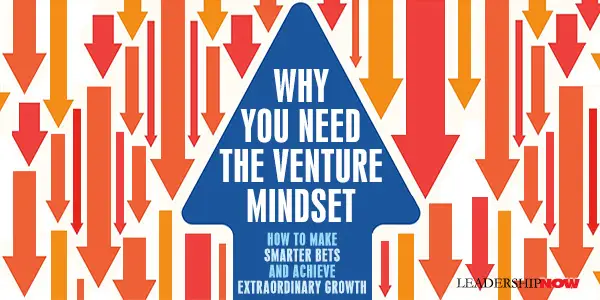
WITH uncertainty as a given, we need to approach what we do with a different mindset. Innovation is key to sustainability. The Venture Mindset offers a way to rethink your decision-making process. Ilya Strebulaev conducted the largest survey of VC investors, held hundreds of interviews, and collected what became the largest database of unicorns and unicorns-to-be and their founders. This search revealed many practices of VCs. Together with a venture builder Alex Dang they translated these learnings into practical lessons for traditional organizations and present them in The Venture Mindset. So, what is the Venture Mindset? The Venture Mindset is a new mental model where failure is a must, due diligence is put on its head, dissent is encouraged, ideas are rejected in their myriads in search of a single winner, plugs are pulled, and time horizons are extended. Here are the nine key aspects of the Venture Mindset, the most important guiding principles: Home Runs Matter, Strikeouts Don’t VCs worry more about errors of omission than they do about errors of commission. Most organizations get that turned around. The concern is not the chance of failure but the risk of missing out on the possible success. “The goal is not to win each time. The goal is not to miss the opportunity to win big at least once.” That means that you have to experiment and be comfortable with accepting failure. Every decision made will not be a win. To win in the end, “you need to be making bolder, riskier plays than you think” without betting the farm. Have more than one bet. It is important, too, to weed out your portfolio of ideas and focus on the most promising. “Too many ideas may distract and disorient the management.” Get Outside the Four Walls Work giving consideration for what is happening outside your organization. “Corporate decision makers have lots of people and resources at their disposal within their four walls. As a result, project ideas arise from what is available within the organization.” Source ideas and deals from outside and from unusual places. Go wide. This inability to source deals from outside the four walls, and to do so quickly, is one of the main reasons why innovation in so many companies is stifled. The pipeline of ideas inside your four walls is simply not big enough. The challenge is often not a lack of resources or smart people, but of a critical mass of ideas or too great a similarity between those ideas. Too often, organizations select initiatives from a small number of internally available options. In an uncertain environment, you need to be more curious. Prepare Your Mind When deciding to invest or move forward, VCs take a red-flag approach. They ask, “Why don’t I want to invest?” “VCs reduce the seemingly inordinate complexity of deal selection by searching for a decisive reason to reject an opportunity rather than advancing it to the next stage of consideration.” What is the way out of this idea? The reasons to go or no-go become obvious when you have prepared your mind to see them. “VCs rely on their pattern recognition skills, developed through numerous meetings with entrepreneurs and hundreds of hours spent flipping through pitch decks and industry studies and connecting the dots in the vague universe of startup facts and outcomes. It may seem, even to them, like a gut decision, but it has been foreshadowed by a long period of tireless effort.” Pattern recognition happens when you back off and take the 10,000-foot view. Say No 100 Times Say no more but thoughtfully. Consider many ideas, but funnel each idea through a funnel or criteria. Most will not make the first stage or cut. Those that do keep working them down through the funnel to identify the best idea. The authors advise: “To avoid lemons, evaluate more cars! Expand your idea and become disciplined about how you go through it, using different criteria at each stage.” Bet on the Jockey The team is key. The human element matters. VCs distinguish between “startup failures” and “founder failures.” VCs “are unhesitant to keep betting on the founders if they determine that the was not because of the founders.” Execution matters. “VCs know that ideas are a dime a dozen; execution of the idea makes all the difference.” Venture capitalist Georges Doriot advised, “Always consider investing in a grade A man with a grade B idea. Never invest in a grade B man with a grade A idea.” When designing an intrapreneurship culture, keep in mind: “Internal startups are run by highly motivated lean teams, without clear supervision from above, yet with tacit support and broad orientation of direction.” Too many traditional organizations hope that a single person from a large tech company can make the difference. A single person cannot. You need a team. By bringing multiple people with a new mindset in, you can kickstart innovation. Innovation is a team sport indeed. Agree to Disagree Be wary of consensus. When uncertainty is high, and there are many unknowns, consensus is a danger and often biased. “People compromise, converge, and seek consensus.” For stability, go for consensus; for breakthroughs, rely on the VC mindset way, VCs are not consensus seekers. They love arguing, fighting for their view of the future, listening carefully to others across the table, and kicking ideas around. The majority often rules, but that doesn’t mean the majority is right. Seek disagreement. Replace the need to be right with the satisfaction of discovering the truth. Get junior team members to talk first before seniors can tilt the discussion in a specific direction. Assign a devil’s advocate. You need those in the group who are “ready to dissent, disobey, stick to their views, or rebel against the others.” (This describes many entrepreneurs.) Remember, “silence in the room does not mean consent; rather, it is a strong sign of potential disaster.” Double Down or Quit Keep your options open. “To win in the long run, you must be flexible and ready to change your mind every time you collect more information.” We get attached to our decisions. “Our human nature resists reversing course and cutting our losses, even in life-or-death situations—and especially if we think we are so close to being on top of the world. Inexperienced players don’t fold frequently enough. We simply want to be right—even though we already suspect that we were wrong.” Always avail yourself of an unbiased perspective. Make the Pie Bigger VCs know that everyone who shares the pain must share in the gain. “The Venture Mindset solves the principal-agent problem by making everyone a shareholder. Instead of looking for ways to get a larger piece of the pie, everyone is busy growing the pie. Imagine that you are the founder of a very successful startup. How much would you own when your company hits an all-important IPO milestone? When we disclose the average percentage, many are surprised. Only 15 to 20 percent of the shares are typically left for all the cofounders. The founders of Lyft, Box, and Pandora kept only 6 percent, 4 percent, and 2 percent, respectively. Why would people accept such arrangements? Because VCs and founders of VC-backed companies prefer a smaller slice of a larger pie rather than the other way around. Great Things Take Time Think long-term. The changes coming will not happen in a single budget cycle. These are long-term trends and must be considered with long-term thinking and planning. Patience and long-term thinking free the mind from unnecessary limitations and push us to think about what might happen to the world in five, ten, or fifteen years. They force us to look beyond day-to-day routines. Extend your horizon and focus on the journey and not the final destination. Adopting a Venture Mindset begins with people and their mindset. Experiment with small bets. Start with a current issue and consider ways to break the status quo. What might be done? 
Posted by Michael McKinney at 05:53 PM
09.11.23

10 Key Lessons for Entrepreneurs from the House that Cheese Built
IT ALL STARTED with cheese. Miguel Leal didn’t start out wanting to make cheese. He was just looking for a “job that would help me survive the disaster of my father’s death and the mess I’d made of my own education and life so far.” Cheese found him. Learning all he could from the cheese manufacturers he worked for in both Mexico and the United States, he eventually started Mexican Cheese Producers with his partner David Webster. They built into a multi-million dollar company before selling it to Sigma Alimentos. Lean shares the ups and downs of his journey in The House that Cheese Built. It is a heartfelt, interesting story. From his experience, he pulled together ten key lessons for entrepreneurs: 1. Hard Times Can Be Your Best Teachers. “Because I had no means of support other than my own wits, I became adept at watching other people and learning through observation and experience. Desperate to better myself, I applied a laser-like focus to every task in front of me, learning what I needed to know.” 2. Be Your Own Best Customer and Make Something People Want. “Think about what you want that isn’t already out there. Focusing on the marketplace and testing what your customers want is a much surer strategy for growth than trying to outsmart your competitors.” 3. Take Satisfaction in Achieving Small Steps Toward Your Goal. “Thinking too far in advance can cause you to stumble and give up because it makes your goals seem impossible to reach. Instead, set small, incremental goals that are realistic to achieve. You’ll make steady progress that way.” 4. Get Your Emotions Under Control Before Making Important Decisions. “In the business arena, just like in every other part of your life, certain events will spark strong emotions … and you find yourself obsessing over what happened. Your vision tunnels, and you can scarcely breathe because tension is like a lasso around your ribs. But no good business decision can be made in that kind of emotional state. Pause and take a breath. When you’re calm, consider your options, actions, and potential consequences. The act.” 5. Everything in Life Happens for a Reason—Even Obstacles. It’s easy to say, “I can’t do it,” when we hit a roadblock. “Instead of letting myself quit, I persisted, tackling one roadblock at a time and viewing each obstacle as a new learning opportunity. Practice saying yes to new opportunities whenever you confront a roadblock. Sometimes, if it’s hard to jump over an obstacle, people make the mistake of not moving because they’re afraid of falling down. But if you want to succeed in business, you must keep finding new ways to push through obstacles, hurdle over them, or go around them one step at a time until you reach your desired destination.” 6. Let Failure Inspire You. “Take joy in learning from your mistakes and let failure inspire you. Otherwise, life will surely keep hitting you in the same spot. Each problem you resolve is a learning experience.” 7. The Rhythms of Life Will Change as You Succeed, but Stay Alert. “Imagine your business as a tiny snowball and you’re pushing it up a mountain. The higher you get on the mountain, the more snow you gather (and maybe some rocks, too). As the snowball gets bigger and bigger, it will take more effort to keep pushing it up the mountain. Finally, you reach the summit, and suddenly your journey is a downhill one. However, even though your effort will change—you will no longer be pushing that snowball to maintain momentum—you can’t take your eye off the snowball.” 8. Happiness and Success Are Never Permanent and Are Not Tied to Wealth or Ambition. “Happiness and success are intangible things. Only you can define what they mean to you, and those definitions will likely shift over time. A fulfilling career is never about the money, in the end, but about realizing your true passions. The same is true of relationships.” 9. To Succeed in Business, You Need to Persuade Others to Take a Risk on You. “Develop a strong, consistent personal brand that evokes confidence in everyone around you, especially financial partners. This means demonstrating consistent reliability in your ethics and consistency in how you show up.” 10. Develop an Exit Strategy. “Your exit strategy should be based on examining your own physical and mental health, whether you’re in a position to build a legacy company for future generations, and evaluating whether you have money enough to live according to your own needs and values—not some arbitrary dollar amount.” 
Posted by Michael McKinney at 11:39 AM
03.27.23

How to Enhance Involvement by Younger Generations in the Family Enterprise
YOUNG ADULTHOOD today is a challenging life stage. It is rife with struggles related to managing the emerging responsibilities of adult life. If ownership or management of a family enterprise is an expectation, the pressures only mount. Family enterprise ownership requires deep commitment and responsibility. To effectively step into the role, it takes a great deal of emotional maturity, interpersonal skillfulness, and an understanding of an owner’s role and responsibilities. Unmanaged expectations on the part of the present owners toward the rising generation could result in a breakdown in family relationships and potentially spell doom for the family business. Expectations run high when a family looks to its young members to take the necessary steps to assume leadership and/or ownership of the family enterprise. Those in the emerging adult stage (ages 18 to 28) are in a critical time for ownership development. Yet they’re also in the throes of developmental changes that include learning to become independent from their family — both in proximity and with relation to financial dependency. Some may want to pursue a career separate from the family enterprise, while some who join the family business may feel an extra level of intensity around performance expectations. It’s normal for young adults to wish to forge their own paths during this stage. Older family members must create space for connections and learning while enabling emerging adults to explore and express their independence. It is important to help them understand that the door to involvement in the enterprise is open and that there are many paths to contribution. Importantly, given the social and cultural context of business today, it can be particularly challenging for members who fall into Millennial (born 1981-1996) or iGen cohorts (born 1997-2012) to step into an established family enterprise. Millennials, for example, are observed to prefer jobs that make a difference over those that provide a large salary, and their iGen counterparts show less interest or movement toward independence. Contrast what these generations face with that of Baby Boomer patriarchs or matriarchs (born 1946-1964) who are all about action and who expect their children and grandchildren to want to be just like them. They may look down on their Millennial family members who prefer a more balanced life. Development of these emerging adults as enterprise owners needs to be approached with empathy and thoughtfulness. For the multigenerational family enterprise to thrive, owners and managers need to be open to co-creating the future while recognizing the different values, aspirations, and goals between the Baby Boomer, Gen X, Millennial, and iGen cohorts. This entails: 1. Building and maintaining a strong family dynamic. Too often, senior generations move into ownership development without recognizing that a strong emotional environment in the family is a necessary foundation. This includes having values-driven behavior, open communication, constructive expression of emotion, appreciation for the diversity of skills and interests, and so on. Families need to aim for positive family experiences that help members form a sense of “together, we are stronger.” This can occur by sharing stories about individual members who live the family’s values. However, this involves showcasing a diverse set of values, including ones that cross generations so as to promote a feeling of inclusiveness and respect. One family professionally designed “family trading cards” similar to those popular in sports, creating experience across generations. 2. Becoming a learning family. A learning family proactively designs learning opportunities to advance both individual talent and the collective brain trust. It begins with a commitment by individuals to manage their biases as they experiment, take risks, and try new ways of doing things without fear of reprisal or getting it wrong. Family members give and receive feedback openly and constructively. While learning is considered a continuous process, a tangible goal is the ability to trust one another and communicate and collaborate for the long term. 3. Making learning a two-way street. It is useful if both older and younger family members are willing to allow the sharing of wisdom and create space to learn from each generation’s values. The senior generation may need to develop new skills to better share its wisdom and legacy and to give the next generation space to grow and become confident and capable as the “new guard.” 4. Marrying passions with business issues. Engaging family members in learning is more of an art than a science. It requires patiently exploring areas of individual interest and passion and marrying those with business needs and priorities — ideally in creative ways. One family involved in the pet products industry engaged members of the rising generation who loved cooking by setting up a cooking class with a specialist to develop dog and cat food recipes. It was a huge hit! 5. Respecting diverse viewpoints. Members of family enterprises are often dispersed and diverse in multiple dimensions — including age, gender, geography, knowledge, abilities, values, interests, and family roles. Placing value on the diverse set of collective learning styles and intelligences in the family not only cultivates inclusiveness but also potentially offers ways of thinking and doing things that, through synergy, may amplify your competitive advantage. This involves respecting others’ opinions and seeking common ground without forcing one single preference or perspective on other members. Seeking consensus (not unanimity) through fair process yields greater commitment and engagement over the long term.  
Posted by Michael McKinney at 07:54 AM
03.10.23

Burn the Boats: Toss Plan B Overboard and Unleash Your Full Potential
IF you’re looking to expand your thinking, then look no further than Burn the Boats: Toss Plan B Overboard and Unleash Your Full Potential by Matt Higgins. For those of us that have always heard, “Always have a Plan B,” burning the boats may sound reckless. What Higgins is saying is that “you don’t win when you give yourself the option to lose.” Should you process risk? Absolutely. Ask yourself, “What is the worst that could possibly happen?” If that is survivable, then burn the boats. To accomplish something great, you have to give yourself no escape route, no chance to turn back. You throw away your backup plans and you push forward, no longer bogged down by the infinite ways in which we hedge our own success. Essentially it comes down to: why do we hesitate? Burn the boats is about overcoming that voice in your head that holds you back—creates doubt. It’s easy to think that you’re not good enough regardless of what you have achieved or where you are at. “Before we can burn the boats, we have to be confident in who we are, unafraid of being felled by the forces gunning for our demise.” You’ll always have detractors. They can be useful as to where you’ll find resistance. They are often negative because they lack knowledge about what you are doing. They are envious because your success makes them look bad in their mind. Then again, we allow our insecurities and negative self-talk to tear us down before we even get started. Our weaknesses and shame can be our strength. “Whatever you worry is holding you back is just part of your story. Everyone has parts of their story that they ruminate about, hide from the world, or feel embarrassed to discuss. But once you realize that we all hold those kinds of secrets inside, their power over you diminishes.” What are you carrying around—the things in your life that you revisit over and over—that could make you lighter if you would reframe it and shed it? Leaning into your differences—those things that make you unique—will help you to not hedge your bets. Researchers at the Wharton School of the University of Pennsylvania found that the mere contemplation of a Plan B diminished the team’s performance and motivation. “You can’t waste your mental energy looking for a way out or an alternative plan. All of your energy needs to be directed toward your goal or you’ll never reach it.” There are behaviors and thinking that strongly influence our outcomes. Wrong partners can derail you. And sometimes, you are not the one to lead the company forward. Maybe you are the Visionary, and you need a good operator—a Catalyst type—to make it happen. When you want to quit on an idea, you have to ask yourself, is it the idea I’m bored with, or is it really time to bail? “Familiarity breeds contempt. We get burned out and sick and tired of hearing our own stories, even if most of the world hasn’t come close to hearing them yet. You need to structure your big bets in life to give yourself time to be right.” And you should place big bets, not incremental ones just to play it safe. “If it’s worth going in at all, then I would make the case that it’s worth going all in.” When we get scared, we want to slow down and take small steps instead of big leaps. “But all that does is extend our journey and give us more and more opportunity to turn back.” The notion of incremental progress is just our attempt to impose order onto the chaos of life and reduce success to some kind of discernable formula. Pay your dues and you’ll be rewarded with upward mobility. In reality, the greatest spoils usually go to the ones who refuse to submit to a typical roadmap. To make those big leaps, Higgins says, “find people who re better than you at everything one could possibly need to do, and submit to what makes them incredible.” Through the examples of people who had to cross that barrier of doubt and fully commit to their potential, you will find parallels to your own experience. It’s all here on the pages of Burn the Boats. I think every anxiety, fear, crisis, or doubt you might experience is found in the many examples Higgins shares. When we see ourselves in their life stories, we get the feeling that if they did it, we can too. 
Posted by Michael McKinney at 07:01 AM
12.12.22

Why Startups Fail: Six Issues to Avoid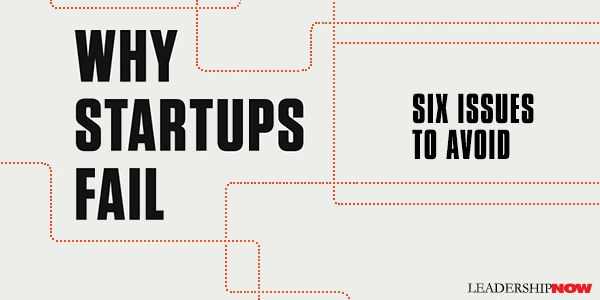
THE FACT IS most startups fail. More than two-thirds of them never deliver a positive return to investors. Tim Eisenmann is a professor at Harvard Business School, where he’s led The Entrepreneurial Manager, a required course for all of their MBAs. While he taught students how to build winning startups, he felt he wasn't giving them the full picture if he couldn’t identify why so many were failing. So, he set out to find out. The result is Why Startups Fail: A New Roadmap for Entrepreneurial Success. Eisenmann introduces the Diamond-and-Square framework to help aspiring entrepreneurs know whether they have actually identified an attractive opportunity and determine what types of resources are required to successfully capitalize on it.
The four elements in the diamond collectively specify the opportunity: what the venture will offer and to whom; its plan for technology and operations; its marketing approach; and how the venture will make money. • Customer Value Proposition: This is the most important. A new venture absolutely must offer a sustainably differentiated solution for strong, unmet customer needs.
To capture this opportunity, the venture will need the right resources in the right amounts as indicated by the four outside “square” elements. • Founders: The founder fit can have a decisive impact on venture outcomes. Co-founder conflict can tear a startup apart.
It is easy to blame the founders. Eisenmann went deeper and identified six patterns of failure, looking at ventures that initially showed promise but subsequently crashed to earth because of errors that could have been averted. The vast majority of startup failures can be attributed to these six reasons and can be divided into three cases for early-stage failures and three cases for late-stage failures. Eisenmann explains each using examples of startups that fell prey to these sources of failure. Good Idea, Bad Bedfellows People are the most common cause of failure. Although startup success is thought to rest mainly on the founder’s talents and instincts, the wrong team, investors, or partners can sink a venture just as quickly. Entrepreneurs sometimes identify an attractive opportunity but fail to mobilize the resources needed to capitalize upon it. Deficiencies may include poor founder fit — due, for example, to conflict between cofounders or their lack of relevant experience; other team members’ shortcomings; low value-added by investors; and lack of alignment between the venture’s priorities and those of strategic partners. Startups are more likely to be vulnerable to the Good Idea, Bad Bellows failure pattern when they pursue opportunities that involve 1) complex operations requiring tight coordination of different specialists’ work; 2) inventory of physical goods; and 3) large, lumpy capital requirements. False Starts Many early-stage startups fail after their founders rush their first product to market, skipping upfront research that would determine whether they have identified strong, unmet customer needs and the best solution for those problems. As a consequence, the venture’s first product is likely to miss the mark. The entrepreneur can pivot, but they have boosted their failure odds by wasting time and money on a flawed first product. Entrepreneurs can avoid false starts by undertaking a thorough and thoughtful design process before commencing engineering work. Iteration should stop only when you’re confident you have formulated a compelling customer value proposition. False Positives Early adopters and mainstream customers have different needs, and both need to be tested. Crowdfunding campaigns may demonstrate a product’s appeal to product category enthusiasts, but they don’t provide data on mass-market demand. Success with early adopters can be misleading and give founders unwarranted confidence to expand. Success with early adopters can be misleading and give founders undue confidence to expand prematurely — or, if the needs of mainstream customers differ from those of early adopters — head in the wrong direction. Once the mistake is evident, the venture can correct course, but pivots can be costly once resources have been committed. Speed Trap Despite the pressure to “get big fast,” hypergrowth can spell disaster for even the most promising ventures. Hypergrowth can put great strains on a startup, and these strains can prove fatal when growth is not profitable — that is, when the marketing costs incurred to acquire a new customer exceed the profit the venture can expect to earn, over time, from that customer. To avoid you need to ask four categories of questions—known as the RAWI test—to determine if you are ready to scale successfully: 1. Ready? Does that startup have a proven business model?
Help Wanted Rapidly scaling startups need lots of capital and talent, but they can make mistakes that leave them suddenly in short supply of both. In contrast to Speed Trap victims, some startups manage to sustain product-market fit as they scale but stumble due to shortfalls in management talent or capital — or both. Delays or mistakes in recruiting senior leaders for mission-critical roles can derail a venture, as can the sudden shifts in investor sentiment that can foreclose access to capital — even for healthy startups. Cascading Miracles The bigger the vision, the more challenges you face, and a shortfall with any one of them could be enough to kill the vision, thus requiring a cascade of miracles to succeed—a moonshot. How much innovation is too much? Some entrepreneurs pursue audaciously ambitious venture concepts that require many years of product development, coupled with breakthroughs on several fronts, for example: radical shifts in customer behavior; the cooperation of established corporations that have benefited from the status quo; government support in the form of subsidies or favorable regulation; or investors willing to commit vast amounts of capital over extended periods. If any requirements are not met, the venture may fail. Consequently, the entrepreneur needs a cascade of miracles to succeed. Dealing with Failure Should you call it quits? Failure is typically a slow-motion affair, so it’s easy to hang on to false hope. And there is the founder’s ego that takes a hit. If you are faced with this decision, there are four questions you need to ask yourself: 1. Are you out of moves?
Eisenmann covers how to shut down and how to bounce back. For those that want to try their hand at a new venture, the good news is that for those “who preserved relationships with team members and investors by engineering a graceful shutdown,” most will not experience any meaningful stigmatization or rejection. Take responsibility for the failure and know what you learned that can be applied to your next venture. Eisenmann says it is “an amazing ride, creating something out of nothing. So go build something great.” 
Posted by Michael McKinney at 07:35 AM
11.11.22

How MIT’s Unique Culture Created a Thriving Entrepreneurial Community … and You Can Too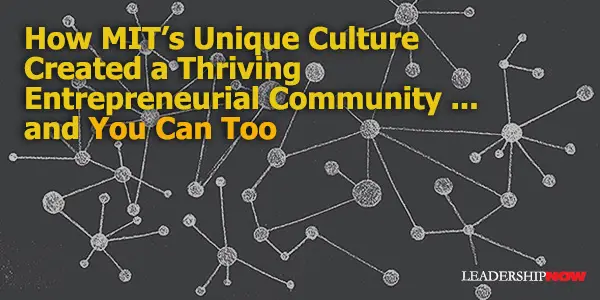
AS OF 2015, Massachusetts Institute of Technology (MIT) alums have founded over 30,000 active companies that employed 4.6 million people. And together, they had revenues of 1.9 trillion dollars. In From the Basement to the Dome, Jean-Jacques Degroof explains why MIT has become such an entrepreneurial hotbed and what we might learn from it to improve our efforts. Recreating the MIT entrepreneurial ecosystem is not easy. It is a culture that has developed over many years and not from deliberate policy by the Institute. “Entrepreneurship at MIT sparked and began to thrive as the result of the isolated initiatives of alumni, students, and individual faculty and staff members, primarily in the realm of extracurricular activities, especially in the early days.” We may not be able to recreate the secret sauce, but there are lessons and principles that we can take away and apply to our institutions and organizations. First, let’s look at some of the history of the MIT entrepreneurial movement. Karl Compton was president of MIT in the 30s and realized that the “launch of new venture commercializing emerging technologies requires those companies to have access to their own source of capital. Thus, the intuition behind venture capital was born.” And so on “June 6, 1946, the American Research and Development Corporation (ARD) was incorporated. It was the first institutional venture capital firm. Over the years, ARD invested in 120 companies and also spun off other venture capital firms, effectively launching the venture capital industry and the venture capital-backed firm. ARD’s most successful investment was the computer firm Digital Equipment Corporation.” MIT professor Leo Beranek—of Bolt Beranek and Newman fame—said that “One of the reasons that MIT has been so important in the world has been that they were willing to encourage their professors to start businesses. . . . And of course, MIT had the proper kind of teaching so that the students got to realize that maybe one of the best things they can do is to invent something and start a company.” In 1961 MIT offered its first-ever entrepreneurship course: New Enterprises. It would remain the only graduate course in entrepreneurship until Corporate Entrepreneurship was launched in 1972. “This was a sign of limited interest on the part of the students and of the low status of entrepreneurship in academic circles.” The approach has been practical. “The strong commitment to learning by doing and to solving real problems has endured to this day and has constituted a fertile ground for the faculty, students, and alumni to develop an interest in entrepreneurship in recent decades.” In 1988 the MIT Entrepreneurs Club was launched to encourage entrepreneurship and foster critical networking. It was formed because “at MIT back in the 1980s, there were lots of people with interesting ideas, but few opportunities for people to meet to discuss them or to learn how to turn the ideas into companies, and there was little interaction between the people developing technologies in the School of Engineering and those with expertise in business at the Sloan School. The club was conceived as a way to meet that need and to bridge silos that existed between the management and the engineering side of the campus.” It was also open to alumni. Former alumni had said that “entrepreneurship is a form of intellectual immigration, consisting of leaving one’s comfort zone and going somewhere where you cannot take anything for granted.” And “Entrepreneurs create an organization that didn’t exist before. They have a scarce amount of resources with which to do that. They are the underdog. Entrepreneurs, by definition, try to challenge incumbents.” As entrepreneurship requires thinking outside the box, it requires thinking across disciplines and domains. “One of the few reliable rules drawn from research in entrepreneurship is that diverse teams of start-up founders perform better on a range of outcomes. A general prerequisite of most MIT entrepreneurial contests or accelerators, for instance, is that participants form mixed teams of scientists and engineers with management students.” These projects often result from fortuitous encounters and informal relationships built across these porous spaces. Working on side projects is a good way to find cofounders. “When you build stuff for fun, it gives you the highest likelihood of meeting similarity-minded people. And when you’ve already worked with people before on past projects, there’s much less risk and a higher chance of success later on.” The Martin Trust Center for MIT Entrepreneurship “sees its mission, first and foremost, as educational. In addition to teaching students how to launch businesses, its objective is to teach students how to develop an entrepreneurial mindset. Thus, it focuses on instilling an entrepreneurial skillset and mindset within students, as opposed to churning out start-ups.” The Trust Center’s motto: “We don’t build start-ups. We build entrepreneurs.” Entrepreneurial thinking can be taught. “MIT clearly stands on the side of those who believe entrepreneurship can—and should!—be taught as a key engine to feed innovation.” There is a strong belief at MIT that entrepreneurship is a team sport. It is based on the evidence that teams of founders tend to perform better than individual founders and that complementary teams tend to do better than homogeneous teams. Following on the heels of the I-Teams class, nowadays, most teams in entrepreneurship-related courses or contests are required to be composed of a mix of engineering or science students with management students. What can we learn from this? As we have seen, openness to bottom-up initiatives and decision-making is a well-ingrained, bottom-up organizational dynamic at MIT. Learning by doing and problem-solving—taking what we have learned out into the real world to test for relevance and to iterate on our ideas. Entrepreneurship is not a science but a profession and a way of looking at the world. Experimenting and tolerance to failure. Entrepreneurship fits perfectly into such an approach because it is also a process of experimentation and trial and error. MIT’s tradition of a multidisciplinary approach to problem-solving goes a long way to enabling novel solutions based on a unique combination of disciplines. Too often, we see entrepreneurial programs operating independently of engineering and the sciences. MIT’s motto, mens et manus (“mind and hand” in Latin), and its logo — which features the scholar and the craftsman in parallel positions — are about using what we learn to make a positive impact on the world. Embracing those who think differently from you. The identity of being an outsider is alive and well at MIT. There is pride in and respect for the rebels, the disruptors, the upstarts, and those pursuing unconventional solutions. 
Posted by Michael McKinney at 07:46 AM
08.15.22

3 Things You Need to Do to Unlock Your Potential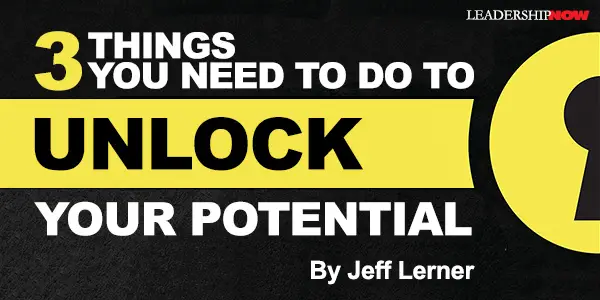
AT 16, I began my summer job working in the office supply room at a prominent local law firm. After three weeks of being treated poorly, I expressed my frustrations to my boss. I was fired by the end of the day. That job was my first and last taste of the corporate world. So, I did some soul searching. The experience confirmed what I already knew deep down, that I was not cut out to work a traditional job, so I decided to pursue music instead. I figured if I was going to have to trade my time for money, it should at least be for doing something I enjoyed. Seeing high school at that point as just an early form of job training, I convinced my parents to let me drop out and pursue a career in music. They allowed it and even bought me a piano to practice on, but they were also quite clear that I was making my bed and would have to spend the rest of my life sleeping in it. I agreed and got to practicing — 10, 12, and 14 hours a day. I was obsessed — anything to avoid ever having to get another job. By my early 20s, I was earning a full-time living performing and landed some gigs playing for “the society circuit” — the upper crust of Houston society which consisted mostly of energy executives and successful entrepreneurs. I was fascinated by these wealthy people who had the creative freedom of a musician but none of the financial struggle. Once I connected the dots that most of them owned their own businesses, I became obsessed with doing the same for myself. During my 20s, I failed at 11 businesses, but I didn’t give up. At 29, after my final failure — 2 franchise restaurants which left me almost half a million dollars in debt — I discovered the concept of making money online. I was at the proverbial rock bottom, overweight, getting a divorce, and hiding from creditors, so I figured, what did I have to lose? I maxed out my last working credit card buying a course on affiliate marketing. And it worked, or rather I did … like a maniac. In 5 years, I generated over $10 million in commission with affiliate marketing, then launched a digital marketing agency that did roughly $30 million in sales and landed on the INC 5000 list twice. Eventually, I was presented with the opportunity to sell my agency, and I took it, but I knew I wanted to pursue something else. I wanted to help others achieve the same level of success that I had created. In 2019, I started ENTRE, an online education company on a mission to disrupt the education system and usher a new generation of “ENTREpreneurs” into the world. The rest is history. How Anyone Can Unlock Their Potential I want to make it clear that I truly believe everyone is an entrepreneur and can create any life they want in the modern economy, even if you don’t have a lot of money. To put this into perspective, here is a list of my companies and their total startup budgets: Affiliate Marketing: $14K (grossed $10M in 4 years)
As you can see, you don’t need millions of dollars to start a business. Now, I’m going to list three things you need to do to unlock your potential and create the life you want in the modern world: 1. Avoid Lifestyle Creep Avoid lifestyle creep by holding onto the extra money you receive as your income increases. The next step is to invest in things that either create passive income or reduce expenses moving forward (e.g., buying a duplex and “house hacking” or paying for a car with cash to eliminate loan payments). Just because you have more money doesn’t mean you should spend more. If you do, you’ll be stuck living paycheck to paycheck.2. Take Action Most people think about taking action but are scared to fail. So, they stay where it’s safe and never change or grow. However, your comfort zone prevents you from building the life you want. Anything great comes with the risk of failure.There is no chance for success in entrepreneurship without taking a risk. No one starts off creating million-dollar businesses. They start off creating and failing at several businesses until they find the one that sticks. Even then, that one successful business may not be their million-dollar business, but action was taken, and momentum was gained. 3. Shift Your Perspective I believe risk tolerance is the new security, or at least an essential part of it. The old 40/40 plan (find a job to work 40 hours a week for 40 years and retire) has gone the way of the dodo bird. Every day the Bureau of Labor Statistics or some research firm publishes statistics that validate what we can all feel and see around us: the top jobs of the next ten years don’t even exist today, colleges are woefully behind in teaching the skills that matter most, most employees last an average of less than two years at any given job, and the average person has less than 10% of what they need for retirement, and so on. The institutions that we have put our faith in for the last century (college degrees, long-term job security, retirement plans, etc.) are somewhere between underwhelming and insolvent. And yet, our nervous systems, which evolved over hundreds of thousands of years during which things changed relatively slowly, still prompt us to look around for large, collective institutions we can rely on. But they aren’t there. On the contrary, we need to be relying on ourselves and taking calculated risks. I believe that 10,000 years from now, biologists will look upon this century as the time when the nature of man’s relationship to risk shifted, entrepreneurial creativity and value innovation became the new best strategy, and intelligent risk appraisal became the new evolutionary advantage. Of course, time will tell, but in the meantime, the happiest people I know are already entrepreneurs who take control of their lives and create the life they want using business as a tool rather than a trap, so I’ll continue to take my chances.  
Posted by Michael McKinney at 09:52 AM
05.03.22

Make No Small Plans: Lessons on Thinking Big, Chasing Dreams, and Building Community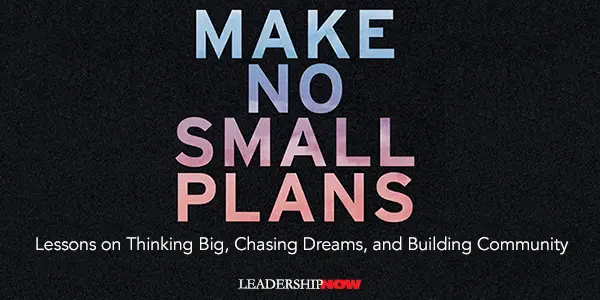
BIG IDEAS are often met with, “It’ll never work.” And if that doesn’t stop us, then our inner voice may make us throw in the towel. Make No Small Plans: Lessons on Thinking Big, Chasing Dreams, and Building Community is the incredible story of how four friends, who in the beginning, had no idea what they were doing—Elliott Bisnow, Brett Leve, Jeff Rosenthal, and Jeremy Schwartz—took Bisnow’s idea and turned it into a reality. Bisnow wanted to “bring together twenty creative people and build a peer group so that we can connect with each other, meet new friends, and brainstorm.” He contacted twenty of the best people he knew, and they all turned him down. The first impression I get from Make No Small Plans is that most of us don’t work as hard as we could. We give up too soon. At this point, many people would just quit or decide they needed a new idea. Bisnow didn’t quit. He upped the stakes. He decided he was thinking too small. And Summit Series was born. “Sometimes you can have the right idea and pitch it to the wrong person.” He went after big-name entrepreneurs and invited them to an all-expense-paid trip to Utah to discuss professional challenges they each faced and collaborate on solutions. To make a long story short, it was the beginning of a journey that would eventually become Summit—a community that inspires and connects entrepreneurs, academics, athletes, artists, astronauts, authors, chefs, engineers, explorers, philanthropists, spiritual leaders, and scientists—co-founded by Bisnow, Leve, Rosenthal, and Schwartz. In building their community, former CEO of Zappos Tony Hsieh gave them some valuable advice at one of their first events: “Are there people at this event who you wouldn’t invite to your parent’s home for dinner if not for their personal and professional success? Another thread that runs through their journey is to leave space for the unplanned. “It doesn’t matter how prepared you are, because the day will never unfold the way you planned it. What matters most is how you react to the unexpected moments.” Takeaways from the journey to build Summit:
Having had a taste of success, they are now looking for smart people doing incredible things—“change-the-world” stuff—and it can become easy to forget that they once only had a dream and a desire to do something special. People who are doing incredible things are already doing incredible things, and they can mentor those with only a passion. Remaining grounded in their history, they need to seek out and encourage the people who are now once like they once were, with only a passion and a dream to do incredible things and make it their mission to change their world. Another good lesson for all of us. 
Posted by Michael McKinney at 11:32 AM
01.24.22

Founded: The No B.S. Guide for Entrepreneurs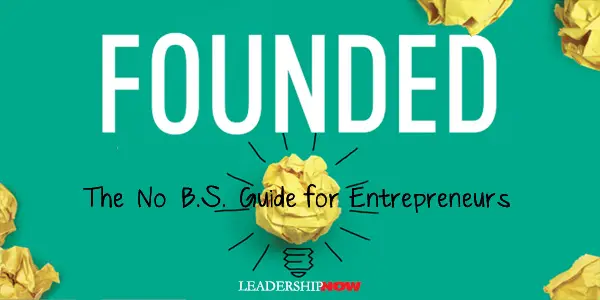
THE thinking required to practice entrepreneurship will serve you well no matter what you do. And it is that kind of thinking that is needed in organizations today. Succeed or fail, the process will change how you show up in the world. Melissa Kaufman and Mike Raab are serious about entrepreneurship in ways that too many schools with entrepreneurship programs aren’t. They are the directors of Northwestern University’s student entrepreneurship program, The Garage. It is a physical space and community designed to teach students an entrepreneurial mindset and skillset through experiential learning. It is a remarkable learning environment. Their book, Founded: The No B.S. Guide for Student Entrepreneurs is, as the title suggests, directed to the college or grad student. It is true, as they say, this time in a person’s life is a great time to work on an idea. “Unburdened by the responsibilities you will shoulder later in life … you’re prepared and more willing to try something totally new. There will never be a time in your life when you are surrounded by so many smart people from different backgrounds and world-class experts in a variety of fields.” And The Garage takes full advantage of that. But don’t be fooled. What they offer here is a goldmine for anyone, at any age, wanting to bring a new idea to life. They begin by making clear that entrepreneurship is not who you are but something you do. It is an activity. This means if you want to be an entrepreneur, you have to do the work. They caution, “Don’t get stuck in thinking or planning mode. Instead, focus on doing. Make a move, gather feedback, make another move.” To begin, you have to think like a scientist and share your idea with others “so you can gather feedback, improve your product or service, and repeat the process.” It is a mistake to keep your idea secret until it is ready for the market. “Until you are getting feedback from people on the basic concept, there is no reason to spend any time on it.” The best founders have “strong convictions, loosely held.” What if someone wants to steal your idea? This is rare. The idea isn’t the valuable thing. But it drives some founders to require a nondisclosure agreement (NDA) from anyone they speak to. The hard reality for these individuals to accept is their idea, in itself, is worthless and that it is almost guaranteed to not be an original or unique one. NDAs are a nonstarter for investors. Why? A founder who asks an investor to sign an NDA fundamentally misunderstands what their job is. Their job is not to have an idea; it is to execute that idea. No matter what your idea is, there are likely many other people working on something similar. Venture capitalists choose which companies to invest in based on which team they think has the highest potential to execute on their vision, not which team had the idea first. You know you are on to something—product-market fit—the authors say, “when growth is not your biggest problem; keeping up with demand is.” They cover the three biggest mistakes that first-time founders make: First, giving up too easily. Second, building something no one wants (“Your initial idea is not going to be exactly the one that people want.”). And third, ignoring distribution—getting your product in front of customers. Finding the right cofounder can make all of the difference. “When you choose a cofounder, you’re committing to a very big adventure together full of very high highs and very low lows.” Get a founder’s agreement in writing early on when things are going well. Include responsibilities and equity. “We recommend that you split up 90% of your equity up front between cofounders. The other 10% can be reserved for future hires and other circumstances.” Part two of the book is full of ideas, tips, and how-tos to get you grounded and headed in the right direction. They cover everything from evaluating ideas to business models, customer acquisition, building a team, pitching your company, pivoting, and understanding financials, to name a few. This book is one of the best books you could read as you think about your first startup because it lays out the realities of starting a business in a very concise, straightforward manner. They close with this thought: Although it is true that the vast majority of startups eventually fail, we hope you have seen through some of the stories that we’ve shared that the experience, knowledge, relationships, and stories gained through practicing entrepreneurship are more powerful than any other job or experience you could have. You’ll never see the world in the same light, and you’ll always be looking for the next opportunity to help others solve a problem and make your own dent in the world.

Posted by Michael McKinney at 07:25 AM
08.06.21

FYI: Your Chaotic Story Is an Asset — So Share It!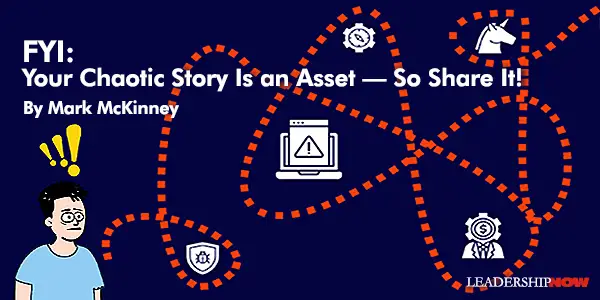
IF YOU’RE LIKE ME, you worry about your startup’s story — or rather presenting it. The pivots, founder feuds, competitors, and development delays are just some of the many hairpin turns that contort your journey into something much more…free-spirited. You and I have realized that we need to strategically and positively frame our stories to raise a successful funding round. Yet, our startup stories can sometimes seem so chaotic that we might mentally predict failure — how on earth can our messy story look appealing? Who would want to get involved in that? We may even begin envying companies with a seemingly more linear (as far as we can tell) storyline. But regardless of our perceptions, the chaotic story you have can actually be an overwhelming advantage if played correctly. Let’s take a look at this extreme example. Enter Jon Medved, the CEO and founder of an Israeli startup fund called OurCrowd. In 2012, Medved was in the process of courting OurCrowd’s first investors. These two New Yorkers had never been to Israel before, so Medved decided to show them around Tel Aviv and introduce them to Israel’s startup landscape. After having an enjoyable afternoon of touring and meeting local entrepreneurs, Medved and his guests were on a highway back to Jerusalem when the sound of spine-chilling air raid sirens began to howl. Rocket attacks on Tel Aviv had just begun, the first attack in twenty years. I pulled over to the hard shoulder and directed my guests to lie down in the dirt by a wall as Israel’s Iron Dome defense system soared into action over our heads. We heard the booms as Iron Dome intercepted the Iranian Fajr missiles overhead, and felt the sickening impact as three of the rockets fired by Hamas exploded a couple of miles from where we were taking cover. After the assaults ceased and sirens fell silent, Medved and the two investors climbed back into the car. On the drive back, Medved had the sickening feeling that the successful day had just been completely ruined — who in their right mind would invest in companies that were threatened by missile attacks? Upon arriving home, the two investors informed Medved that they would reconsider their investment proposal and get back to him tomorrow morning. When I arrived at the hotel the following morning, the investors had already made up their minds. I opened my mouth to speak but one of them stopped me short. Woah. Imagine being told that your company will not only receive the funding it needs but double the amount because of the hardships you’re enduring. Wouldn’t that make you a little prouder of the obstacles you’ve overcome and are overcoming? I think we often get caught up in keeping our journey as neat and as straightforward as possible at the expense of missing the opportunity to demonstrate how strong we really are. Thus, we try to minimize and skip crucial hurdles instead of giving them proper attention — giving how you overcame and progressed forward its proper attention. This isn’t to say that you need to go into gory detail about every embarrassment and roadblock — don’t do that — but you should discuss the highlights of the arduous journey you and your team have traveled. Such a journey demonstrates that you’ve got skin in the game and, most importantly, that the next time an ugly debacle comes your way, you won’t run and let the company fold. Because of your nonlinear journey, you and your team are seasoned warriors unphased by chaos. Just as those Israeli companies turned managing the daily threat of missile attacks into a strength inspiring to investors, so can you with your startup’s journey. As VC Mark Suster said of investors, “it takes a miracle to get investment dollars out of them if they’re not impressed with the team.” A difficult journey that your team has persisted through will impress them. It’s up to you to share it. 
Posted by Michael McKinney at 08:51 AM
07.16.21

Make It, Don't Fake It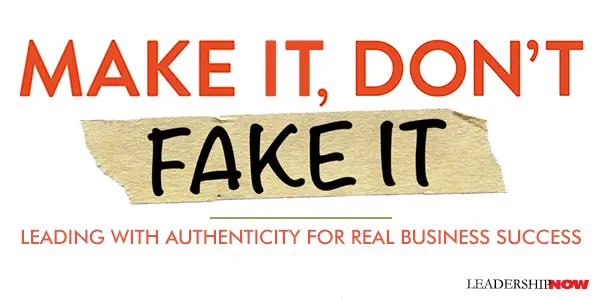
FAKE IT ‘TIL YOU MAKE IT is a common refrain in our culture. But it has been wrongfully used to justify all kinds of poor behavior and outright lies, as Sabrina Horn correctly points out in Make It, Don’t Fake It. Of all the business and career memes to gain popularity, few have compromised integrity in business, leadership, and personal success more than the expression “Fake it till you make it.” With roots in well-intentioned early twentieth-century psychotherapy, this phase has degenerated into a mantra that has encouraged and even normalized lying for the purpose of getting ahead. Now a product of modern American culture that rolls all too easily off the tongue, its mere existence tells you it’s okay to lie, from twisting the truth just a little to flagrantly deceiving others for personal gain. How true. We can’t be surprised by this in a culture that encourages selective truth, self-promotion, and short-cuts. While some use this maxim to fake a persona or misrepresent who they really are, it was never intended to be about lying. It is about becoming. It is a means to become something, not a state of being. In the same way, some people embrace vulnerability to ignore their weaknesses. The vulnerability culture that has sprung up is often used to help us justify our weaknesses rather than facing the truth and doing something to grow them to a non-toxic level. If, in our self-awareness, we realize that our authentic self is getting in our way and undermining our leadership, it’s time we did something about it rather than closing our eyes and slapping an authenticity label on it. Fake It ‘til You Make It is about acting “as if.” If you want more friends, it’s not about going around talking about all of the friends you have, but beginning to act in a way that invites friendships—like being friendly and smiling. Fake It ‘til You Make It is about taking on a mindset to produce results, not playing footloose with the facts, and lying about things that aren’t as though they were. To counteract this cultural condition, Make It, Don’t Fake It is about “ethics, passion, confidence, pride, resilience, commitment, and survival in a business context. It is about doing the right things the right way. This almost always means doing them the hard way.” Varying degrees of faking it falls along a continuum from acting “as if” to outright fraud. Horn discusses these various degrees of fakery—or call it what it is—deceit. In the heat of the moment, most of these fabrications are easy to fall into. It gets us by. But they take a toll not only on our character but also the enduring success that could be ours.
Horn then takes us through her journey as the CEO of a public relations and marketing communications agency. So, she knows what is fake and what isn’t and the consequences of each. We often think of PR and spin as one and the same, but done right says Horn, it isn’t. I like her perspective on it: There is a big difference in intent between misleading people by making something look better than it really is and simply bringing life to what is most compelling about it for the purpose of earning attention, interest, and trust. In our drive to succeed, the temptation is always there to cut corners and misrepresent ourselves. Horn begins with her first pitch to her first prospective client. I walked into PeopleSoft’s main conference room armed with a pack of business cards emblazoned with the initial name of my future company, Sabrina Horn Public Relations, and a logo the resembled a towel monogram. I had no employees, no clients, and except for the business cards, no evidence of a company, really. For anyone that has started their own company, this is an easily relatable scenario. What do you do? Misrepresenting the truth comes to mind. Faking it. Honestly, there were moments I was anxious enough to say to myself, Who am I kidding? This is nuts. They won’t take me seriously, so I had better make something up to sell them on me. But she didn’t. She disarmed her fear with preparation. When you are first starting out, doing and being anything to win the business is tempting—and also dangerous. You have to be bullish and yet stay grounded in the reality of what your company can realistically do, and then target those customers that want what you have to offer, with relatively few modifications. Horn covers what it means to start a business, the emotional ups and downs, the temptations, the risk, controlling growth, and the importance of establishing your values from the beginning. Throughout my career, whenever I was facing a crisis or felt rudderless, I attacked fear, uncertainty, and doubt and any stirrings of the imposter syndrome by referring to factual reality. I sought information to develop new strategies and options. There is a way to do it right. At the core of everything you do is integrity. And that includes creating and staying an authentic brand. The brand is the responsibility of the company’s founders and represents the why or the reason for being. Horn devotes an excellent chapter to your brand and culture and the issues involved in protecting and evolving it in a changing marketplace. She says leadership consists of two parts: winning and losing. While we like to focus on the wins, we will lose more often than we would like. No one is immune. And “it is really hard to act like a leader when you feel like a loser.” Horn shares a significant failure and the necessary after-failure postmortem. The value of a postmortem “is that it makes you face reality and keeps you from laying the blame elsewhere. The truth is, while relationships and stunts do matter, intelligence, insights, creativity, passion, and sheer effort can matter more. You lost, not because of what they did but because of what you didn’t do. There are situations where there’s just no winning. You can’t fake your age or your size or manufacture relationships you don’t have. Stay grounded, align around your core values and mission, and remind your team what you stand for. There is a reason why you and your people work at your company, and why other people don’t. Losing in these situations can be a blessing in disguise. And then there’s winning. When you are on a winning streak, know that things can and will change. Begin to plan for what is next. And a crisis will inevitably come out of nowhere. Plan for it, too, before it happens. Make It, Don’t Fake It is an excellent look at starting and leading a company from beginning to end with an integrity-at-all-costs perspective—how to make it without faking it. 
Posted by Michael McKinney at 12:30 PM
04.16.21

Before You Open a Business…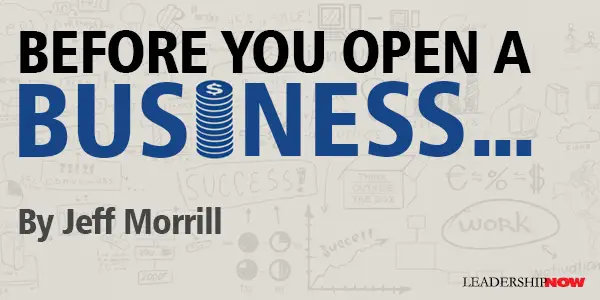
I’VE MET MANY business founders in my life and they vary on almost every possible measure: race, gender, background, temperament, schooling, and intelligence (in all its forms). I certainly observe patterns among them, but they all share one and only one thing in common: they decided to get on the bucking bronco and actually do it. I won’t try to talk you in or out of starting a business. It eventually worked out nicely for us, even with all the sacrifices and tough times along the way. But I’ve seen the pursuit of business opportunities cause irreparable harm to marriages, families, health—and those are some of the successful businesses! A business failure can cause all those problems and many more. For every “American dream” out there, there are more than a few American nightmares. Just because you do the work doesn’t mean the business will work. Some things in business and life are simply out of our control. Bad things happen to good people just as bad things happen to good businesses. There are many ways that even a good business with good leadership can be damaged or bankrupted. Because business is fraught with many risks and challenges, and because this journey isn’t right for everyone, I’ve developed some questions that will help you get more clarity so you can make better decisions for yourself when it comes to starting a business. I resisted the temptation to make it a “quiz” where a certain number of yeses totaled up to give you a red, yellow, or green light. A single “no” to some of these questions might steer you away from entrepreneurship. For example, if your partner isn’t on board, many people might choose to avoid conflicts between “your-wife-or-your-life” or “your-man-or-your-plan.” Others might find that the successful resolution of these conflicts opens them up to new ways of relating to their families and careers. Note that the scale and nature of your business will inform your answers to the following questions. For example, starting a lawn service with a mower and a truck will demand far less investment and risk than borrowing a lot of money to buy an existing landscaping company. Many successful businesses start with a small financial investment and low risk, while others may start with enormous capital, investors that have to be placated, and lots of risk. As you consider these questions, remember the best indicator of how you’ll behave in a future situation is the way you’ve behaved in the past (especially your more recent actions and inactions). For additional insight on the tough ones, ask a close family member or friend who knows you well. Family Questions
Personality Questions
Financial Questions Entrepreneurs reputedly enjoy taking risks. Some do thrive on the adrenaline of working without a net. When I hear about the people who have won and lost multiple fortunes, I think they must enjoy the thrill of rolling the dice. But the majority of the business owners I know prefer to manage risks by minimizing them or bypassing them entirely. Army combat veteran Colonel David Hackworth said, “If you find yourself in a fair fight, you didn’t plan your mission properly.” Most successful entrepreneurs seek the deals where the odds of success significantly outweigh the potential for failure. For many years, I personally bought our used cars at the auctions. By specializing exclusively on Subarus and obsessively immersing myself in that world, I gained a modest competitive advantage over most of the other buyers in the country. I thoroughly understood all the factors that influenced the value of the cars, and I was on the showroom floor every day interacting with the customers who were buying them. Every time I bought a car, I took a bet. Each bet was small enough that even a big mistake would hardly put us out of business, but I piled up the small winnings from all these bets every month until we were buying 100 used cars a month at auctions. I developed a strategy that generated a lot of revenue with minimal risk, although it took a lot of time and effort. You could say I liked to roll the dice, but only when they were loaded in my favor. Imagine you’re the player in an imaginary casino where you can bet on red or black, and you’re right consistently more often than you’re wrong. If you never bet too much to go bust, and you play long enough, you’ll do really well. (This just happens to be the way a real casino makes money from the players.)
 
Posted by Michael McKinney at 08:29 AM
04.12.21

6 New Rules for the Digital Age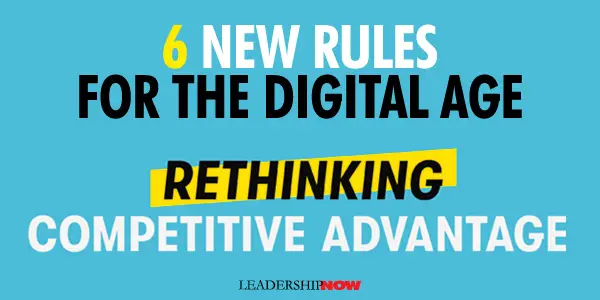
EVERY NOW AND THEN, a book comes along to give you the insights you need to see and understand the world you live in and how to thrive in it. Rethinking Competitive Advantage: New Rules for the Digital Age by Ram Charan is one of those books. The ideas and terminology you’ve heard and read about come together here to give you a holistic view of where you need to go next. Charan has taken years of observation and distilled it into six practical rules to guide you into this digital age. To begin: In the digital age, competitive advantage is the ability to win the ultimate prize—the consumer’s preference—repeatedly, through continuous innovation on behalf of the consumer, and to create immense value for the shareholders at the same time. As opposed to: Until recently, the greatest competitive advantage went to companies that controlled distribution channels, had hard assets on the largest scale, or had established brands or patents. In other words, it’s more about what a company does than what it has. Digitization defines the playing field. “The old adage ‘stick to your knitting,’ for example, a colloquial version of ‘build on your core competence,’ tends to narrow a company’s imagination. Yet a bold imagination is a requirement for leaders today.” Digital companies like Netflix, Amazon, Google, and Alibaba, have certain elements—or approaches—in common: • They imagine a 100x market space that doesn’t yet exist.
These elements lead to six rules that a leader must work with if they are going to thrive in the digital age. The way forward is understanding the new rules of competition and playing a different game. Charan explains several roadblocks like—an overreliance on outdated theories—to moving forward in the digital age that insightful. The first four rules represent building blocks for building a competitive advantage. The last two relate to the human side of bringing this all together. Rule #1. A personalized consumer experience is key to exponential growth. The digital companies connect with the end-user and creating a customized experience. They work from the end-user backward. The customer is not the retailer but the end-user. “The key is to identify an experience that can both be personalized and appeal to a very large number of people, regardless of national or cultural boundaries.” Most traditional companies don’t think big enough. Rule #2. Algorithms and data are essential weapons. Algorithms and data must become central to your business. Charan distinguishes digital capability and digital platform. Digital capability usually means that the company has utilized algorithms to improve internal processes. In contrast, a digital platform is “a set of algorithms that collect and analyze data. Combining and refining algorithms over time helps a company build a competitive advantage.” Converting to a digital platform should be done incrementally. Leaders must understand what technology can do for them and have good judgment about how to use it. A digital platform can personalize the consumer experience, create market spaces of 100x, eliminate intermediaries, utilize dynamic pricing, and use data to uncover opportunities for exponential growth. Rule #3. A company does not compete. Its ecosystem does. The ecosystem is the arrangement between partners that can be created. “Moving forward requires seamless systems and technology platforms, taking advantage of the latest technical developments, meeting a range of consumer preferences, and processing massive amounts of data to improve the outcome of things.” Conceiving these ecosystems takes imagination and a specific set of leadership skills. Fundamentally, “it’s about building relationships with people from other cultures and with different incentives.” The predominant challenge is to conceive of the ecosystem in its entirety, how it will deliver a great experience for the consumer, how the partners will enhance each other capabilities, and how success will be measured and shared. Rule #4. Moneymaking is geared for huge cash generation, not earnings per share, and the new law of increasing returns. Funders understand the difference. When it comes to digital companies, earnings per share is not the focus. Revenue growth and cash gross margin is. Moneymaking is different in the digital age. Of course the components of moneymaking—things like revenues, cash, gross margin, cost structure, and funding—are the same as ever. But the emphasis, the patterns, the timing, and the relationships among them are different. In digital companies, as revenues grow, so does gross margin because of the law of increasing returns. As digital companies grow revenues and improve percentage gross margin, they exponentially increase their gross margin in cash. In essence, they become a cash-generation machine. The digital connection that digital companies have with their customer base makes it easier for them to keep them engaged and gather more data. “Algorithms can then help detect the causes of certain behaviors, including customer defections, and test ways to improve the customer experience.” Rule #5. People, culture, and work design form a “social engine” that drives innovation and execution personalized for each customer. The social engine, a company’s culture and way of organizing work, helps drive the growth of the big digital companies. Most of these digital giants operate with only three or four layers below the CEO. Organizing into functionally focused teams makes for better and faster decisions and implementation. Important too is who is on those teams. Who you choose to lead those teams speaks volumes about the values of the company. Beyond just plain competency, you need people who want to learn, grow, and get things done. Laslo Bock said that at Google, they “disqualified anyone who gave even a small signal that they might not be collaborative or intellectually humble.” Once established, the culture becomes a magnet for others who share those values and behave that way. Rule #6. Leaders continuously learn, imagine, and break through obstacles to create the change that other companies must contend with. Speaking of intellectual humbleness, leaders must be at the forefront of curiosity and learning—continuously growing. “Any company that is or wants to be digital must have leaders who match up against the criteria a digital company requires.” The main difference Charan sees between traditional leaders of legacy companies versus leaders of digital companies has to do with their “cognition, skills, and psychological orientation.” Among these traits are: They have the mental capacity to think in terms of 10x or 100x, to imagine a future space that doesn’t exist, and the confidence that they will overcome whatever obstacles they might encounter. They have a facility for and are comfortable with data-based analysis. Facts and knowledge—not predictable outcomes—give them the courage to act. There is fluidity to their thinking. They welcome change and even seek it. They are hungry for what’s next and are willing to create and destroy. Their psychology is geared toward high speed, urgency, and continuous experimentation. They are literate in the application of algorithmic science and value fact-based reasoning. They are willing to reconceptualize the organizational structure so that decision-making takes place closer to the customer to improve the speed and quality of decisions. This insightful and very accessible book is one of Charan’s best. It should be widely read. Even if you do not want to join the current reality and perhaps go down with the ship, at least you’ll know why. Here are a few more thoughts from the book: Dissatisfaction with the status quo and a search for what’s next is a universal human endeavor. It does not reside in one person, department, or organizational layer. The flow of ideas cannot be blocked by bureaucratic layers. Do the people at traditional companies welcome change? What happens to the good ideas that emerge? How quickly do they get converted into action? 
Posted by Michael McKinney at 08:52 AM
01.18.21

How I Built This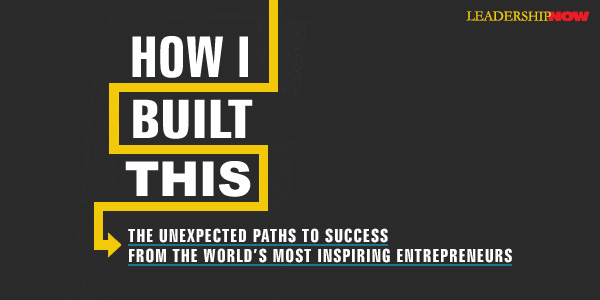
TAKING AN IDEA and building it into something tangible. That’s the entrepreneurial journey. Guy Raz interviews innovators, entrepreneurs, and idealists to create a narrative of their journey from spark to movement in a highly successful podcast on NPR and now a book entitled, How I Built This. How I Built This is an inspiring book that succeeds as a practical guide to the entrepreneurial journey. After interviewing hundreds of founders and CEOs, Raz says they are just like you and me—human. They all have sleepless nights and midnight terrors. Most of them, at some point, feel like imposters. They are not natural superheroes; they are all Clark Kents. The only difference between them and you, at this moment, is that when opportunity presented itself, they went into the phone booth and put on the cape. They took the leap. Raz has taken the lessons from the shows and structured them to “follow the path we took as we traced their entrepreneurial hero’s journeys from the call to found their businesses, through the tests and trials of their growth phases, and finally to their destination as mature, global brands we know today.” His goal is to “pull back the curtain on entrepreneurship, to shed light on the black box of entrepreneurial success, and provide an architecture for how to think creatively about building something, whether that’s an idea, a movement, or, of course, a business.” Embedded in these stories of entrepreneurs are business advice and life lessons. If the entrepreneurial journey does nothing else, it teaches you a lot about yourself. Here are some of those lessons:
The one thing Raz has learned from all of the people he has interviewed is this: Be kind; that kind leaders have kind companies; that kindness is a powerful tool; that kindness is free—it costs nothing!—and that return on investment for kindness is bigger than that for any financial investment an entrepreneur can make. As the stories in this book unfold, you will see that all entrepreneurs are good at dealing with rejection. The entrepreneurial journey is fill with “no.” It is their curiosity that often saved them and got them moving again. Starting a business is never easy, but if you have, or if you are thinking about doing it, you need to read this book. (And don’t forget to read the Afterword. It’s inspiring and helpful.) 
Posted by Michael McKinney at 07:45 AM
10.19.20

The Entrepreneur’s Faces: 10 Entrepreneurial Types and Their Journey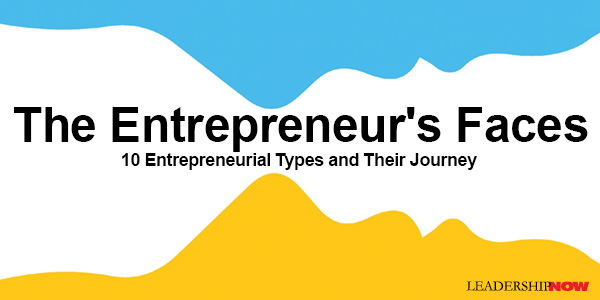
THE leadership we need now can be found in the entrepreneurial mindset—the characteristics found in entrepreneurs. Authors Jonathan Littman and Susanna Camp have categorized the nature of this mindset into ten types or faces in The Entrepreneur’s Faces. More than just static labels, there you’re your pathway into the entrepreneurial mindset and the solutions that can bring. As if the changes in technology haven’t left many wondering what to do next, the reaction to the COVID-19 virus has left many leaders in a kind of limbo. The authors write: We’re adrift – lacking the stabilizing force of the office, the social grounding of a shared workplace, essential interactions with colleagues. For many of us, the pandemic has interrupted our goals and stolen our sense of purpose. We need new ways to lead during the crisis – from how to reshape our careers or work, to how to craft a fresh collaborative model in this instantly all-digital age. They look at these ten different entrepreneurial faces in the framework of the seven stages of the entrepreneurial journey they call The Arc. The Arc illustrates seven stages that all entrepreneurs pass through. In The Entrepreneur’s Faces we get an inside look at ten everyday entrepreneurs as they work through the challenges unique to each stage in the journey.
It is helpful to see how they grow and approach the issues they face from their dominant “face.” Better yet, you can see how they adapted using other faces as needed as they moved through The Arc. Different situations call for different faces. Knowing where you are can help you determine what kind of partners you need to navigate to success.
The Awakening It all begins with the Awakening. It changes how you look at the world and sets you on a path of discovery. The awakening is about something unseen—a surging rush of confidence. You begin to believe you’re capable of more than you’d planned. More than others had expected. You begin to trust that the process is worthwhile and rewarding in an of itself. You become less concerned about what you will discover, and more confident that each day you are growing stronger and more capable, more prepared to capitalizes on whatever is next. As the characters in the book show, your face will shape how you awaken. What follows is an excerpt from the book of the awakening of one entrepreneur, Allan Young. Allan Young, born in San Francisco’s Chinatown, is one of the ten characters in The Entrepreneur’s Faces. Allan embodies the archetype we call the Leader. Intent and action bind at the tightest level in aspiring leaders. Despite humble beginnings, Allan set out on a conscious, focused, and ultimately inspirational journey to become a leader. Allan shed his earlier shortcomings and went on to help lead a wildly successful venture capital fund while still in college and later created Runway, one of San Francisco’s greatest tech accelerators. Allan Young’s Awakening Allan Young’s parents were Chinese immigrants. His mother was a seamstress. His father juggled two jobs, stocking the shelves of a grocery, and working in a hardware store until late. Their work ethic didn’t sink in. Allan was a screw-up. “I wanted to have fun instead of sit in class,” he said. “I’d cut school. Go shoot hoops, or hang out at the Chinatown library.” Yet his fondness for rebellion included a strong streak of intellectual curiosity. In the third grade, he learned to code in BASIC, and loved reading. But computers were for nerds. So he made “a conscious decision to play sports, to be a gangster.” The world needs leaders who are Awakening. Pain often comes before an awakening, but it leads to openness and discovery. A Faces Quiz is available at TheEntrepreneursFaces.com 
Posted by Michael McKinney at 09:41 AM
09.04.20

Just What Do You Mean, Entrepreneur?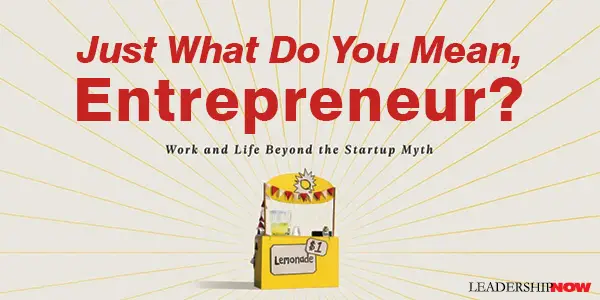
WHEN WE THINK about entrepreneurship, we tend to fixate on people like Steve Jobs, Elon Musk, Richard Branson, Jeff Bezos, and Phil Knight. And why not? There are very few budding entrepreneurs that would not want to duplicate their success. So, we study what these people did to try and find the perfect checklist or formula that brings us the same kind of success. The only problem is this doesn’t reflect the real world of entrepreneurship. David Sax, author of The Soul of an Entrepreneur, says that a startup myth has developed that has “increasingly defined what an entrepreneur was supposed to look like, how they behaved, and what they did. That myth “established that entrepreneurs were brilliant and young, mostly male and white, highly educated lone geniuses who frequently dropped out of college because they were so singularly focused on a brilliant innovation that would transform industry, and maybe even in the world, through economic disruption driven by blitzkrieg growth and fueled by venture capital.” The problem is we have come to define entrepreneurship in terms of this startup model when, in fact, it represents a tiny fraction of what entrepreneurship really is. Many more are lifestyle businesses and self-funded. Furthermore, the highest success rates among entrepreneurs come from founders in middle age and beyond with the average age entrepreneur “behind the fastest-growing new companies (especially in the technology sector) was forty-five years old.” We need to turn our attention to what an entrepreneur really is and why they do it. David Sax began a search for the soul of an entrepreneur. He asks, “Why do entrepreneurs do it? Why do they keep at it, even in the face of tremendous odds, and the daily personal sacrifices, and the imminent threat of financial failure? Why does the entrepreneur matter, why do different types of entrepreneurs matter, and what’s at stake if we lose sight of their value?” These questions lead him around the world to seek out entrepreneurs from all kinds of backgrounds, cultures, and motivations to find the deeper meaning of entrepreneurship. We journey with Sax to a bakery in Toronto run by an immigrant family looking to get a fresh start. For many immigrants, the need to secure some form of financial survival is the prime motivator of their move into entrepreneurship and is referred to as a push factor. Unlike the pull of an entrepreneur pursuing an attractive idea they simply cannot pass up (a romanticized core of the startup myth), a push to entrepreneurship is driven by necessity, often by a lack of better options, a problem that plagues immigrants. We visit Tracy Obolsky in Rockaway Beach, New York, who begins her day with the rising sun surfing before she heads out to open her lifestyle business—a business designed to cover the expenses and lifestyle ambitions of the owner. The lifestyle business captures the soul of the entrepreneur’s essential hope: To be your own boss. To use your talents as you see fit. To wake up each day and do what you decided to do. To reap what you sow, and build your life around that dream, however big or small it is. We also meet Jesseca Dupart in New Orleans. She leveraged her African American beauty products brand Kaleidoscope, to strengthen her community and to help bring more women like her into entrepreneurship. She says, “You are responsible as a successful person to pay it forward … period! As an entrepreneur, I have to tell everybody you can do whatever you want.” Then there are the social entrepreneurs where the donation is a marketing expense that drives growth. This brand of socially conscious capitalism has become romanticized over the past twenty years or so, as a generation of individuals with strong values began to see entrepreneurship as the vehicle for achieving a desired change, in a way that married the dynamism of business with the broad developmental goals that had previously been the realm of governments and multinational organizations. Sax writes, “what separates empty rhetoric from genuine values-led entrepreneurship is sacrifice.” We journey to Argentina to see Iduna Weinert, the thirty-seven-year-old daughter of the founder of the Bodega y Cavas de Weinert winery. The family-owned business does not fit the startup myth where the immediate goal is an exit from the business. The family is often seen as an impediment to entrepreneurship. But in reality, families have always been a part of entrepreneurship. About two-thirds of the businesses owned around the world are owned and operated by families, and in America, “family firms constitute over half of the businesses in the country and half of those listed on stock markets.” Sax notes that “entering a family business does not make a relation an entrepreneur” and few actually succeed into the second generation. But it does become something of a lifestyle. “Knowledge is cumulative and serves as the base for the next generation’s entrepreneurial ideas and the confidence to pursue them.” Sax expands our view of not only what an entrepreneur is, but more importantly, what it means to be an entrepreneur. Sax talks to entrepreneurs that share their ups and downs, successes and failures. And failure is a very real part of owning a business. Uncertainty is a daily part of business. Only two-thirds of businesses survive their first year. The “essential ingredient that links all entrepreneurs together, wherever they are,” says Sax, is hope. The hope that your idea has worth. The hope that it will sell. The hope that you have the ability to change your fortune … for yourself, your family, the community around you, and maybe even the world. That hope is the persistent faith we gather up in ourselves every single day, as we go out and try to make our ideas work. It underpins the personal risk that all entrepreneurs must accept and allows them to manage it, even when that risk threatens to overwhelm them.

Posted by Michael McKinney at 04:49 AM
08.26.20

No, You Can't
SOMETIMES after you’ve heard it all and seen all of the memes telling you that you can win, you can be anything you want, and the universe is just waiting to hand it all to you, you need a jolt of the very opposite. Sometimes a book comes along and does just that. No, You Can’t: Aim Low and Give Up Winning for Good is the tongue-in-cheek title of Dave Dunseath’s reverse motivation book. No, You Can’t comes in through the back door and gives you— in a humorous way—a shot of reality without personal responsibility, hard work, and intentionality. The unvarnished truth is presented in a such disquieting way that hopefully, the most entrenched pessimists will rethink their approach to life. (Perhaps unintentionally, it also shoots holes in entitlement and the self-esteem movement.) What is a loser? “A loser is anyone who almost touched a star, almost held a dream, or almost got their wish. It’s anyone who doesn’t win and calls it fate or destiny or bad karma or jinxed. Take it from me, once you make your way from Loserindenialus to Loserallthetimeus, you’ll have tons of great excuses to choose from—anytime you need one. All you have to do is let go of what you never were and quit imagining all the things you’ll never be.” Dunseath begins with the Loser’s Creed and a promise: Say it enough, believe it enough, and you’ll feel like you’ve died and gone to Disneyland. You’ll be in a place where you’re never concerned about hard work, a place where you never feel guilty for goofing off all day, a place where nobody expects anything from you, a place where choosing to eat a third corn dog—or not—will be the hardest decision of your day. The book includes the following thoughts that when taken seriously, might reveal areas where some loser thinking that is still lurking in our very own blind spots: What is second place? Second place is merely the highest point a loser can reach. Well, that’s a lot of wrong thinking. It’s jarring. It won’t sit well with you. But that’s the point. The book is a bit of an antidote to the overexposed positive-thinking memes that have become almost invisible on the Internet and fail to register with the negative mindset. They often seem to do more for the poster than the postee. Frequently, another approach is needed. By understanding the loser mindset in all of its forms, we can avoid and help others to avoid the thinking that gets us nowhere. All in all, No, You Can’t is a lesson in human nature. Fortunately, along with all the rationalizations for wrong thinking, anger, and so-called shortcuts, you will find them debunked in a back-handed way. Some of these thoughts found here are the remnants that survive in the back of our minds from the past that come out when times hard or uncertain. The loser-think we all deal with from time to time. Dunseath shows where these thoughts lead, making them easier to extinguish. If you dismiss this book as too negative, you are missing the point. In the end, you begin to see the absurdity of the Loser’s Creed. When taken to its logical conclusion, it makes no sense. Will the day come when I find out that I’m no longer a loser? Dunseath responds: You know what? So many things would have to happen that it’s really not worth worrying over. Your whole life would have to change. You’d have to stop listening to all the people you know who gladly remind you of what’s possible and, more importantly, what is not possible. You’d have to be blind not to see the stumbling blocks and countless obstacles that you’ve learned to avoid so you wouldn’t get hurt. You’d have to see what others don’t, do what others won’t, and believe in what others can’t. He concludes: It’s not complicated. Expect the worst and you’re not only predicting the future, you’re guaranteeing your place in it. So the next time someone suggests you can do something more with your life, be honest and say, “No—no, I can’t, or I would have by now.” That’s really the secret to being everything you’re never going to be. 
Posted by Michael McKinney at 12:44 AM
06.15.20

3 Startup Financing Myths You Should Avoid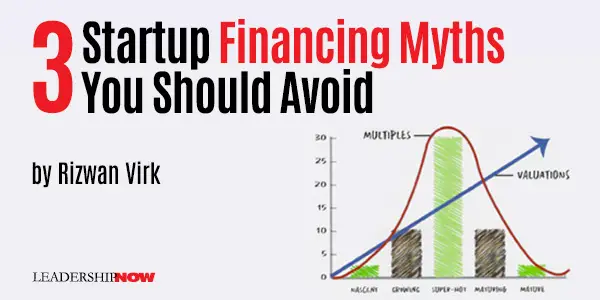
IF you are building a startup, you’ll find no shortage of people who are willing to give you advice, particularly when it comes to raising financing. Unfortunately, much of this advice is wrong. Well not, wrong exactly. Most startup advice, like most myths, have a kernel of truth to them, but you have to know when to apply it and when to skip it. Here are three pieces of advice that are tossed around Silicon Valley as if they are gospel, but they are really Startup Myths. Myth #1: Build a Billion Dollar Company I don’t know exactly when it happened, but at some point, Silicon Valley became obsessed with the word billion. Some people blame it on Justin Timberlake (playing Sean Parker) in the movie The Social Network, who famously said that one million wasn’t cool, one billion was. I personally blame my MIT classmate Aileen Lee, formerly with Kleiner Perkins, who coined the term Unicorn, a private company valued at over a billion dollars. Today the conventional wisdom is not to approach VC’s unless you can build the next Unicorn. To do that, you have to show how your market is big enough (a multi-billion dollar market) to support that kind of valuation. The truth is, if you look at many of the traditional companies that went on to be worth over a billion dollars, it wasn’t at all clear when they started the company that they had a billion-dollar idea. Going all the way back to Yahoo or Microsoft, the initial products (a directory for a nascent tech called the World Wide Web, and Microsoft BASIC,) didn’t look like billion-dollar products at all. The same is true of recent Unicorns like Facebook, Twitter, Slack, Discord, Minecraft and many others. The real issue here is that if an entrepreneur comes in to a pitch and goes on and on about how they’re going to build a billion dollar company in just a few years, most investors eyes tend to glaze over. We’ve heard it all before. So how do billion dollar companies get built? Like Jerry Yang who started Yahoo, as investors we are looking for entrepreneurs who are obsessed with a new technology. Like Mark Zuckerberg, who built a site only for college students, we are looking for a small, protected market that you as an entrepreneur, can dominate. Like Markus Persson, who created Minecraft, who was just trying to build an idea that he could sell for $6.99 a game, we are looking for a product that ends up becoming wildly popular, more popular than anyone thought it could be in the early days. The real key is to have an entrepreneur that is obsessed with a small market. Why does it need to be a small market? Because that’s what an entrepreneur with a small amount of money and a lot of talent can dominate. If, like Microsoft and Facebook, you can dominate your small market, you can then move on to other products or markets that are adjacent. Moreover, if the market grows and you are the leader, then you can find yourself at the helm of a billion dollar company. Even when there is a large market, most successful entrepreneurs attack a small portion of it at the beginning. So, while everyone wants to get in on the next Unicorn, the way to get there is to make sure you have a product that meets the needs of a growing, but still very small, segment of a newly emerging startup market! Myth #2: Talk to As Many Investors As You Can For some entrepreneurs, raising financing can seem like a full time job, particularly in these trying times. Anyone who’s been through the process will tell you that you have to go through a lot of “No’s” before you to get to a “Yes.” If talking to investors is turning out to be a full-time job, it’s possible that you are talking to too many investors or that you need to refine your pitch. Gurinder Sangha, a securities lawyer who started Intelligize (sold to Lexis-Nexis), put it best when he said that you want to go after investors that are “in your tribe.” Who is in your tribe? In the U.S., it’s often your alma matter. Sangha was a graduate of the University of Pennsylvania, and his first venture capital investor turned out to be an alumnus. It doesn’t always have to be alumni. My first institutional financing came from people who were in the “MIT” network. A few years ago, an entrepreneur was building an automated job matching site in Latin America. He would fly into Silicon Valley, meet with many investors, and having read that raising money was easy here, go away disappointed. In the end, the fund that led his series was a fund that focused on Latin America. This might seem obvious, but it’s not. Many entrepreneurs waste time talking to investors who are at the wrong stage, sector, or tribe. When a VC’s website says they do “early stage” – to a VC that means a product has already been built and generating some revenue, while to an entrepreneur, it means “just an idea.” When raising institutional financing, you are better off finding your tribe and focusing on investors who are more likely to invest in your particular market, stage or team. To do this, talk to less investors, not more. Myth #3: Take the Highest Valuation You Can Get Valuation is a touchy subject for most entrepreneurs. They seem to take it personally when an investor isn’t willing to negotiate on valuation. At first glance, this doesn’t seem like a myth at all. Of course, you will take the higher valuation, because you’ll give up less of the company, right? The problem is that most entrepreneurs don’t truly take the time to understand what’s in a valuation. I used to think a valuation was kind of like the stock price of a public company. I got a $5 million valuation on my very first startup and thought I was a millionaire because I owned half the company. I was wrong. Setting aside the issues of valuation of common stock vs. preferred stock, what I really didn’t understand was that a valuation is a set of expectations. The expectations are about how quickly the company can grow and how big it can grow to justify the valuation. While expectations in a private valuation are not as explicit as they are in public companies, they are still there. I always caution entrepreneurs not to take too high a valuation in any round because it sets very high expectations for the next round. Unfortunately, most startups don’t meet their initial rosy projections. What happens then? A down round, which can damage a company and make it difficult to raise money in the future. Another model for valuation is the “high bar,” as shown in Figure 1. Suppose I ask you to set the bar such that I will only invest in your next round if you make it over the bar? In some ways, this is what a valuation is. Would you set it high or low? Of course, you want the bar to be set low rather than high, to guarantee that you’ll make it over. The investor might not want it to be too low in this case. A valuation is basically a bar that you are expected to jump over. This is why experienced entrepreneurs can usually get a higher valuation from VCs than less experienced ones – because the VCs expect them to be able to build a company to a higher valuation more quickly.
Of course, there are other reasons not to always take the highest valuation. Strategic investors might be willing to give you a higher or lower valuation than VCs because they have different priorities, etc. The point is that the highest valuation isn’t always the best one to take. These are just some of the many myths that are given as advice when entrepreneurs are trying to raise financing. If you follow advice blindly without understanding the underlying complexity, you are likely to get yourself and your startup into trouble.  
Posted by Michael McKinney at 06:19 AM
05.04.20

5 Tips for Pitching Investors Remotely in the Time of Coronavirus
NOW that almost everyone is working from home, startup founders looking to raise money from investors will need to do so remotely. In fact, in-person pitches may now be a thing of the past. As both an individual investor and venture capitalist, I’ve taken a lot of remote pitches since the shelter-in-place order started. My impression is that most entrepreneurs aren’t always putting their best foot forward. Here are five seemingly contradictory tips to keep in mind while pitching remotely. Tip #1: The Slides Aren’t the Pitch The first tip will be relevant for both in-person and remote pitches but is doubly important when you are pitching remotely: the slide deck isn’t the pitch. The pitch is the story that you are telling. So, what do I mean by the story? This is a sequential narrative that captures the main reasons why an investor might want to invest in you. It doesn’t matter how good your slides look; it matters how compelling your story is. Just like story beats in a movie script, which is meant to evoke responses from the audience, a story in the context of pitching to investors should consist of certain beats that are meant to elicit their reaction. Paradoxically, the better the story, the worse the slides can be. When I was an entrepreneur raising money, one of the most effective pitches was for the Tap Fish video game. I only had simple black and white slides with text and no images. If that seems like it violates everything you’ve read and heard about putting together pitches—you are right! Our story was great, so the slides didn’t have to be. Here is an outline of the basic story, along with the ER (expected reaction):
A few years later, I was raising a subsequent round for my next video game startup, Midverse Studios. By then, we had a more experienced team thanks to the success of Tap Fish. We had flashier games that were based on the TV shows Penny Dreadful and Grimm. We also had marquis investors, who put money into our seed round, and we had a more impressive set of slides. Despite the flashy slides, we found it difficult to raise money. The fact of the matter was that the slides were better, but the underlying story wasn’t nearly as good. This was because the market for mobile games had become more competitive, making it difficult to acquire users cheaply. We also didn’t have nearly as many users, and we certainly weren’t even close to profitability. We needed a new story that would captivate users and investors. The real takeaway from my experience is that before you assemble your slides, make sure to articulate your skeleton of a story that will evoke the desired response from investors. Tip #2: Use Your Slides in the Remote Pitch Now, this might sound contradictory to Tip #1, but going through some slides is even more important these days when pitching remotely than before the current health crisis. In recent times, it seems the trend is that entrepreneurs will email me their slides before the call. But then, during the call, they completely ignore the slides. It’s as if they expected me to have memorized the slides for the call. Instead of being able to focus on their message with the guidance of slides, I found myself rifling through the collection of slides to find the right one. Out of my last five entrepreneurial pitches, all five had sent me the deck beforehand. Yet only one actually brought up the slides on the Zoom call and went through them with me. The rest just wanted me to look at them sitting on their desks at home, not wanting to “bore me” with the slides. This was a mistake. Now I’m not saying you need to go through every single slide on a remote pitch. You can certainly economize and jump around. But the visuals are actually important when you are trying to make a point to an investor who is attempting to understand your story and has been listening to a multitude of pitches. For one thing, it’s harder for an investor to figure out what the heck your product actually does on a remote pitch. I’m more likely to remember you if there is a catchy visual that illustrates an important point, as opposed to just telling me that point. So, if you have a deck, bring up the slides while talking to investors on Zoom. Otherwise, they’ll just remember you as another face on a screen. Tip #3: Don’t Spend Too Much Time on the Product Traditionally, entrepreneurs love to talk about their product, but investors need to know about more than just the product - the market, the team, competitors, business model, etc. Recently, I saw an entrepreneur’s deck that was 30 slides long, with 10 slides about the product (features, roadmaps, videos, and screenshots). This was too much. Try to keep your deck to 10-15 slides (with extras you can draw upon if necessary). Some pitches have too little about the product, and some have way too much. The best pitches have “just enough” so that an investor can understand what their product offers and why it might be special. One or two slides about your product are enough if you do it right. Then it’s time to move on to why it’s better than other solutions, followed by the business model and how you are going to make money. Tip #4: Explain What Your Product Does Some entrepreneurs go too far in the other direction and make it really hard for the investor to figure out what their product does clearly. This has led to pitches that are “market heavy,” such as many slides of data about the market. To be honest, if I took your pitch, I am probably already interested in the market. So the market slides are somewhat important, but you don’t need more than 2 slides on the market, so don’t dwell on them. For example, if your startup is in esports, you’ll have the obligatory slides talking about how many hundreds of millions of viewers of esports there are. However, as an investor, I probably already know this, or I wouldn’t have taken the pitch. What I really need to know is your segment of the market, what your product is, and why it’s better or different than others. If I had to pick the one thing that takes the most time in remote pitches, it is figuring out what the heck an entrepreneur’s product actually does! Many entrepreneurs get to 2/3 of the way through the slides and start talking about the business model and financial projections while I’m still wondering exactly what their product does and what makes it unique. Having a screenshot or two displayed while you explain your product helps tremendously. So remember Goldilocks—having too little or too much on the product can both be big problems—you have to get it “just right.” Seems obvious, right? You would think so. Tip #5: Identify a Killer Slide Investors Will Remember and Repeat I always tell entrepreneurs whether they are conscious of it or not, an investor leaves with a positioning in their mind about you and your company. This is how the investor will position your company to their partners (if they are a VC) or to other investors, or even to their spouse (if they are angel investors). If you aren’t clear on what they positioning will be, it’s likely you aren’t clear on your story, which brings us right back to Tip #1. The best positioning is usually the single strongest point that you have in your presentation. Typically, it is about your team, market opportunity, technology/product, or market results/ traction. You can go through 15 slides, but in the end, there is one slide that will get an investor. I call it the killer slide. If you are in a new market and don’t have anything to show yet, but have a team that has had real success before (by selling a company), or you are a team that worked together at Google, then the killer slide is the team slide. These days it’s become fashionable for entrepreneurs to put the team slide at the very end of the presentation, which is great for Demo days. But if the team aspect is your biggest strength, then you need to be sure that you establish your credibility up front, so put that first. Because up until that slide, the investor is thinking: “Who are these yahoos, and why should I care about what they say?” If your biggest strength is your technology or IP differentiation, you better have a simple visual, which makes it easy to understand while also hammering home your IP is so important. It’s important is that the investor remembers the “gist” of why your IP is so special after your conversation. Spend more time on this “killer slide” and hammer in the point. Sometimes, the “big strength” is a product demo, which isn’t in the slides at all. I recently invested in a VR company whose founder told me that the way he sells investors is to get them to put on VR glasses and meet him “in world.” In this case, it is necessary to get people over the hurdle because the VR market is not as “hot” as it used to be when it was seen as the “next big thing.” All investors have to justify their actions to someone else (partners, LPs, spouses, etc.). This is why it’s extremely important to not just convince an investor, but to arm them with a positioning they can take to others to justify their investment. Conclusion There is, of course, no one way to do a good pitch remotely during these trying times. But for many startups, it’s even more critical that you raise money quickly, at a time when investors are growing more and more cautious. Almost all good pitches have a good, solid story behind the slides. Moreover, guiding the investor to the right slides is even more important when you are pitching remotely rather than relying on the investor to “get it.” You aren’t there to just chat—you are there to pitch. Remember to keep a “just right” approach to all the sections of your pitch: market, product, competitors, business model, and team. Ensure that you don’t have too much or too little on any one section. Most importantly, think about what the investor will say about your company after the pitch. If it’s not what you want them to say, then your pitch needs work!  *Atmos is a text-based, mentor management, and retention platform, that accurately connects university students to mentors in a more personalized and efficient way than ever before. From BlueSkyAI. 
Posted by Michael McKinney at 07:06 AM
03.11.20

5 Leadership Lessons: Tireless—Key Principles That Drive Success Beyond Business School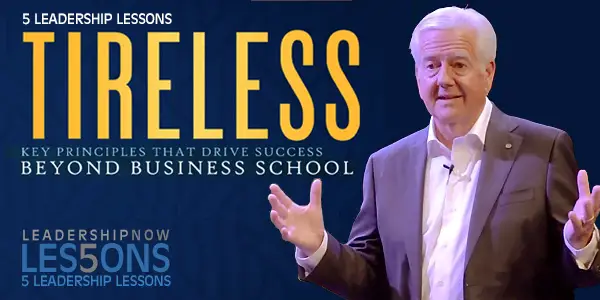
YOUR NEXT DECISION could dictate the trajectory you take. In Tireless, Kim Lorenz encourages us to look for opportunities both as an entrepreneur and in the company where we work, that will propel us to success. Lorenz co-founded two companies that he eventually sold to Fortune 500’s. He shares his experiences and those of others to give us a picture of the principles that bring success and the mindset required to see the opportunities in front of us. Here are five thoughts from Kim Lorenz:

Posted by Michael McKinney at 07:45 PM
03.09.20

5 Leadership Lessons: Built Not Born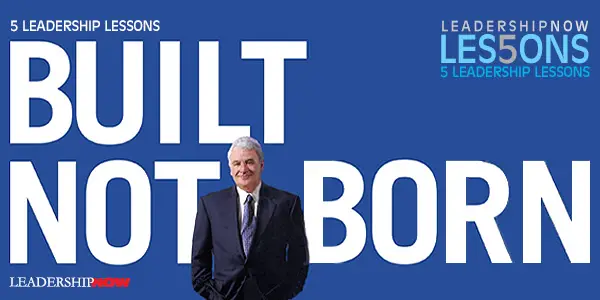
IF you are considering starting your own business or struggling to get one off the ground, Tom Golisano’s Built Not Born will be very valuable. Entrepreneurship is not easy, but it can be rewarding, provided you keep some basic business principles in mind. With $3000 and a credit card in hand, Tom Golisano started what has become today the multi-billion-dollar Paychex. Golisano takes us through what he experienced from start to finish, what not to forget, and what the business owner is responsible for and the importance of understanding every aspect of your business. Much of the advice is obvious, but in the thick of running a business, all too easy to forget. And Golisano keeps the critical issues front and center. “Running a business, any business, means challenges, some expected and others that come out of the blue. It comes with the territory. It’s an old aphorism, but it’s true nevertheless: If you can’t stand the heat, get out of the kitchen.” While entrepreneurship is not for everyone, going in well-informed is essential to success.
Always keep in mind, a lasting legacy is built on we, not I. 
Posted by Michael McKinney at 08:02 AM
02.17.20

How to Get Venture Capital: Secrets of Sand Hill Road
VENTURE CAPITAL is not right for every business. But if you determine that it is right for you, you should read Secrets of Sand Hill Road by Scott Kupor, the managing partner at Andreessen Horowitz. It is a book for those with big ideas. Beginning in the 2000s, capital became more abundant due in large part to the costs required to start a new company. Consequently, the amount of money a start-up needs to raise has declined significantly. Beyond that, there are more angel investors to provide early-stage funding. And the size of the funds has increased as institutions have contributed to VC funds allowing them to fund growth throughout a startup’s life cycle. VC firms stay with their investments longer (upwards of ten years), often providing advice, support, a network of relationships, and coaching to improve the odds of success. Of course, most investments don’t work out. 50 percent don’t. 20 to 30 percent of businesses invested in make a return over the investment. 10 to 20 percent are home runs where an investment returns ten to one hundred times the investment. It’s those home runs that make the whole thing work. Understanding those economics will help you to align your objectives with the sources of the funds you need. VCs don’t always get it right because, at the beginning, there are really no hard numbers to go on. To determine if funding your venture is right for them, they look for three things: 1. People and Team If the idea is a good one, we have to assume that there are others thinking about doing the same thing. “So what matters most is, why do I as a VC want to back this particular team versus any number of the x-number of other teams that might show up to execute this idea? A decision to invest means that the VC cannot invest in a different team that may come along and ultimately be better equipped to pursue the opportunity.” VCs are trying to determine whether this founder will be able to create a compelling story around the company mission in order to attract great engineers, executives, sales and marketing people, etc. 2. Product Because the original idea is not likely the idea or product that will ultimately go to market, the VC wants to know how the founder came up with the idea. They want to know the process. They like founders that “have strong opinions but ones that are weakly held, that is, the ability to incorporate compelling market data and allow it to evolve your product thinking.” In other words, “they want to be comfortable that your process of evaluating the market needs to date is robust enough to enable you to adapt appropriately to changing market demands.” The idea or product also must be significantly different to move people. Great illustration of this point: Ben Horowitz uses the difference between a vitamin and an aspirin to articulate this point. Vitamins are nice to have; they offer some potential health benefits, but you probably don’t interrupt your commute when you are halfway to the office to return home for the vitamin you neglected to take before you left the house. It also takes a very, very long time to know if your vitamins are even working for you. If you have a headache, though, you’ll do just about anything to get an aspirin! They solve your problem and they are fast acting. Similarly, products that often have massive advantages over the status quo are aspirins. VC want to fund aspirins. 3. Market Size What matters most is the size of the market you’re going after because the bigger the market the better the odds of a home run. Kupor delves into how VCs are funded and why it matters to the entrepreneur. Specifically, ask how old the fund is from which you are receiving payment. If it is generally towards the end of its life cycle, there is will be additional pressure on you to return capital or exit. Also, at the beginning of the life cycle there are generally funds reserved for additional rounds of funding. Importantly, he covers what form your company should take (C Corp), stock vesting, up-front agreements, intellectual property, and employee option pools. How much money should you raise? This is something founders often get wrong. The simple answer is: “to raise as much money as you can that enables you to safely achieve the key milestones you will need for the next fund-raising.” Raise the first round with the second round in mind. Thus, if you are raising your first round of financing (typically called the Series A round), you will want to raise an amount of money that gives you enough runway to get to the milestones you will need to hit to be able to successfully raise he next round of financing (the Series B) at (hopefully) a higher valuation than the A round. In the discussion of the art of the pitch, Kupor notes that VCs aren’t expecting you to be clairvoyant, but “you do need to demonstrate to the VCs that you are the master of the domain you are proposing to attack and that you have thought about every important detail of your business in a way that shows depth of preparation and conviction.” Kupor also covers the less exiting—but critical—legal and financial aspects of funding like term sheets, valuation, voting rights, the board, stock, insurance, vesting, and founder issues. Actually, he covers it in the most straight-forward manner I’ve ever read. Secrets of Sand Hill Road is a must-read for anyone considering entrepreneurship. Kupor takes the mystery out of funding and clearly explains why things work the way they do. You will discover the inner workings of the VC-Founder partnership. If you are an entrepreneur, this book will help you get to know your partner. 
Posted by Michael McKinney at 08:13 AM
01.22.20

What Robert Greifeld Can Teach You About Getting Your Organization On Track
TURNING AROUND an organization requires a new story. A very clear and well-told story. When Robert Greifeld was asked to take the helm of Nasdaq in 2003 to execute a turnaround, he came with a new story. As he relates in Market Mover, the story had five parts: 1. Get the Right People on Board
In any cultural or business turnaround, the right people make all the difference. You can’t predict the future, so you need people that get the new story. You can’t control circumstances, but what you can do is to ensure that you have the best people in place so that when the world changes around them, they can adapt, respond, and step up. That’s why my motto has always been people first. He believes that you should promote before you recruit and offers this advice on finding them: Often, the people who are right for the new culture are not individuals who thrived under the previous regime. Change the culture, and inevitably, people with skill sets more apropos to the next context suddenly stand out. He wasn’t looking for just smart people, but people with bandwidth. That is, people with the “capacity to fruitful focus one’s attention on multiple areas.” He also encouraged debates among his executive team. The point of the debate wasn’t to enact a perfectly democratic ideal. It was to achieve better clarity on all of the issues involved so everyone understood the reasons for proposed changes, and my decision-making was both transparent and much better informed. Next, Greifeld had to get people working on the right things. “A common trait of those who fail, I believe, is that they end up working on the wrong things.” Prioritizing is the challenge. As a leader, I consider it my job to focus on what’s not working. Optimism is essential if you’re to take risks and succeed; indeed, it’s probably true that the only people who really accomplish things are the optimists. But that optimism must be tempered by a disciplined and critical perspective. A focus on cash is vital, but it’s important to remember that you can’t save your way to success. “When a culture is focused entirely on thrift, the next big thing is usually invented somewhere else.” To address the technology gap at Nasdaq, Greifeld went outside to buy winners—smart acquisitions. Today’s outsiders are tomorrow's establishment. Business leaders should always cultivate an attentive disposition toward outsiders, especially in industries impacted by technology. Always be on the lookout for new ideas, products, and technologies happening on the edges of your business ecosystem, where outsiders are developing a different picture of your future in apocryphal garages and basements. Naturally, Nasdaq must deal with regulation and government oversight, but no matter what business we are in, we must sell ideas to others. “Don’t feel like you’re above politics—none of us are. Learn to work with it and use it to increase your competitive advantage. Lobbying is education. It’s an opportunity to get important perspectives on the table so legislatures and regulators can actually make informed decisions.” Motivation to change is easier when you are threatened, but when times are good, when you have things where you want them, change is much harder. You always need to be looking for ways to change and grow. As NASDAQ grew and matured, Greifeld realized that he was not as essential as he had been. It was time to move on. He left the CEO position to someone he promoted when he first arrived, Adena Friedman. “Business is a marathon, not a sprint, and to be a leader in the marathon takes an unusual degree of fitness—mental, emotional, and physical.” Market Mover is of course, full of the nuts and bolts of financial technology and the digital economy, but it is so much more. It is not just about the revival of Nasdaq’s near-death experience but is a course in leadership and the entrepreneurial spirit that drives innovation and growth. He writes candidly of the most critical moments of his thirteen-year career at Nasdaq with each chapter focusing on a headline-making event. He takes us through his response and the lessons he learned. This book will not only help you be a better leader, but the insights you will find here will prove invaluable in guiding you as you build your organization. 
Posted by Michael McKinney at 02:35 PM
10.28.19

Beginner’s Pluck: 14 Principles to Build Your Life of Purpose
YOUR PURPOSE is not out there waiting to be found. Your purpose is something you build. Being clueless is where the adventure begins. Liz Forkin Bohannon is the co-founder and CEO of Sseko Designs. Sseko Designs creates opportunity for women and girls living in extreme poverty, but they aren’t another charity. Instead, they employ women in Uganda to make footwear and accessories allowing them to earn money towards college degrees so that they can stop the cycle of poverty for themselves and their families and eventually move into other fields. Sseko Designs the largest exporter of non-agricultural goods from Uganda to the U.S. Bohannon shares her journey in Beginner’s Pluck: Build Your Life of Purpose and Impact Now. It is well worth reading for would-be entrepreneurs, but the insights and lessons apply to any area of life. Her journey is not what you would expect but you will find it encouraging because it is down-to-earth. Bohannon’s wit and personality come through, making it a joy to read. (She has a Masters in Journalism.) We all have been encouraged to “follow our dreams” and to “find our passion.” She says, “what I think was meant to be a message of encouragement and empowerment is actually creating anxiety, fear, and serious analysis paralysis.” The message is a myth. “Stop wasting your time hunting for a unicorn that doesn’t exist and instead get down to the incredibly juicy, adventurous, life-giving work of building an extraordinary life of passion, purpose, and impact.” This is one of the best books you’ll find on the topic. And one worth handing off to anyone starting out in life. She has distilled from her experience, 14 principles to build your life of purpose. I’ll list them below with a comment from the book to give you a taste of the insights you’ll find here. The Principles of Beginner’s Pluck Own Your Average You. Are. Average. 2. Stop Trying to “Find Your Passion” To believe that your passion and purpose exists, fully formed “out there” … and is waiting to be found is a kind of lunacy. And it puts an awful lot of pressure on you to make the right step and get the right degree and open the right door so the stars align and you can, in a cinematically glorious moment Find Your Passion. 3. Dream Small There are lots of excuses that can keep you from pursuing your Big Dream of quitting your job and becoming a full-time artist who can actually pay their bills and then some. So, make it smaller. Go smaller and smaller until you have no more excuses. 4. Chose Curiosity Over Criticism Curiosity is not only one of the greatest tools we have in building lives of purpose and passion, it’s a mindset that each and every one of us can choose, each and every day. 5. Be on Assignment in Your Own Life Show up like a cub reporter, new on the beat. Start looking around and ask interesting questions, not needing to confirm your preexisting biases. 6. Find and Replace What if every time we thought we should be looking for THE solution, we Found and Replaced “Solution” with “Wicked Problem?” 7. Surprise Yourself If you want to build a life of passion and purpose, you’re best off if you’re willing to be surprised by what it looks like. You might actually build a passionate life doing something that in a million years, you’d never have been able to see coming. And you will never know unless you are open enough to try. You’ll never be surprised if you’re running every idea through a 12-point checklist and making sure it aligns perfectly with everything you think you know about your interests and gifts and experience and natural inclinations. 8. Get Your Steps In Think about having a Fitbit for your life. Doesn’t actually matter where you’re going, so much as that you get your steps in. 9. Get Hooked on Making (and Keeping!) Promises Make a promise that aligns not with what you want now, but what you want most in life. Building a life of purpose and impact is not some mystical, cryptic, cosmic code to be cracked, it’s actually just a series of meaningful promises, small and large, that you actually keep. Do. The. Work. 10. Be Good with Good Enough What is the least amount of time/energy/resources I can put into this concept/idea/dream before I can put it out into the universe and actually start getting real-life feedback that will enable me to make it even better? 11. Stop, Drop, and WOW A spirit of WOW must be intentionally cultivated. 12. Dream to Attract Your Team Your dream will attract your team. Asking for help is one of the most vulnerable and courageous things you will ever do. You will face rejection. But I promise you the hurt is worth having a dream that eventually attracts your team. 13. Don’t Hide from The Shadows The degree to which you can experience true joy and lasting fulfillment is equal to the degree to which you hold space for darkness and questions. 14. Walk One Another Home We were all created in the image of The Divine to partake in the beautiful and terrifying dance of giving and receiving, joy and disappointment, miracles and mistakes. We don’t need you to be anyone else’s hero. We just need more people walking one another home. 
Posted by Michael McKinney at 11:32 PM
10.14.19

Robert Iger's 20 Leadership Lessons
ROBERT IGER has worked for the same company for forty-five years: twenty-two of them at ABC, and another twenty-three at Disney, after Disney acquired ABC in 1995—the last fourteen of those years, as the CEO of Disney. He shares it all in The Ride of a Lifetime. Like the biggest, most exciting rides were once called at Disneyland, he says his time as CEO of Disney has been like a fourteen-year ride on a giant E-Ticket attraction. After sharing a bit of his background, he quickly delves into his career beginning at ABC, and the lessons he’s learned and the principles that have guided him that help “nurture the good and manage the bad.” He explains the thinking behind his habit of waking at 4:15 am. It’s vital to create space in each day to let your thoughts wander beyond your immediate job responsibilities, to turn things over in your mind in a less pressured, more creative way than is possible once the daily triage kicks in. I am certain I’d be less productive and less creative in my work if I didn’t also spend those first hours away from the emails and text messages and phone calls that require so much attention as the day goes on. Iger writes of the key mentors in his career and his relationship with Steve Jobs, George Lucas, and Michael Eisner. Iger truly embraces innovation. When he took over as CEO in 2005, he laid out three strategic priorities saying it should be about the future, not the past: Recommit to the concept that quality matters, embrace technology instead of fighting it, and think bigger—think global—and turn Disney into a stronger brand in international markets. These priorities have guided the company through all of the growth and acquisitions since he was named CEO. Today, Disney is the largest media company in the world, counting Pixar, Marvel, Lucasfilm, and 21st Century Fox among its properties. Its value is nearly five times what it was when Iger took over. You have to approach your work and life with a sense of genuine humility. The success I’ve enjoyed has been due in part to my own efforts, but it’s also been due to so much beyond me, the effort and support and examples of so many people, and to twists of fate beyond my control. What follows are 20 leadership lessons from the book but stripped of the stories that brought them to life. You’ll have to read the book to get that. 1
2
3
4
5
6
7
8
9
10
11
12
13
14
15
16
17
18
19
20

Posted by Michael McKinney at 10:39 AM
10.07.19

Stephen Schwarzman’s 25 Rules for Work & Life
BLACKSTONE chairman, CEO, and co-founder Stephen Schwarzman has written a book about the potential that can be realized when you combine personal responsibility with ambition. What It Takes: Lessons in the Pursuit of Excellence chronicles his life leading up to the founding of Blackstone and the journey to build it into what it has become today. He shares the lessons and the opportunities that have come his way as a result of his success. It is inspiring and instructive. Well worth the time to read. Schwarzman grew up in a successful entrepreneurial family selling curtains and linens in Philadelphia. His Dad was content with the one store. Schwarzman was not. He had more ambition. Even in high school he wanted to create something more than the status quo. Through connections and hard work, he got a popular rhythm and blues group of the late 50s, Little Anthony and the Imperials, to come and play at his school. He learned that “if you want something badly enough, you can find a way. You can create it out of nothing. But wanting something isn’t enough. If you’re going to pursue difficult goals, you’re inevitably going to fall short sometimes. It’s one of the costs of ambition.” But you try anyway. With good grades and being fleet-of-foot, he was admitted to Yale University. Like most freshmen, he was lonely and intimidated. He got through it and during the summer he grew in confidence by taking a job at sea. With a new mindset he began his sophomore year determined to make it create something out of nothing as he did in high school. He started a dorm room business and a dance society to bring girls around. His determination and creativity make for a good read. After graduation he got a job at Donaldson Lufkin Jenrette, went to Harvard Business School and ended up at Lehman. This is where he really learned about finance and discovered his strengths. He left Lehman and in 1985 Schwarzman co-founded Blackstone with his mentor and friend Pete Peterson with a $400,000 investment. Today, Blackstone has over $500 billion in assets under management. But as with all new ventures it had its share of inflection points, setbacks and disappointments. He says, “To be successful you have to put yourself in situations and places you have no right being in. You shake your head at your stupidity. But through sheer will, you wear the world down, and it gives you what you want.” Here are 25 more rules for work and life that are woven throughout his book: 1
2
3
4
5
6
7
8
9
10
11
12
13
14
15
16
17
18
19
20
21
22
23
24
25

Posted by Michael McKinney at 07:51 AM
09.24.19

“That Will Never Work”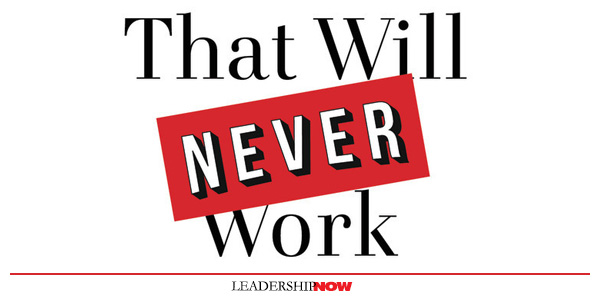
THE STORY GOES that the idea for Netflix came to Reed Hastings after he was hit with a $40 late fee when he returned his rental of Apollo 13 to Blockbuster. Annoyed, he thought, “What if there were no late fees?” And wham, the idea for Netflix was born. Of course, we like stories like that. It’s neat and clean, but in this case, it’s not true. It’s useful though, and it captures in a paragraph the essence of what Netflix is all about. Marc Randolph, Netflix’s co-founder, and first CEO says it’s emotionally true. “Reed’s oft-repeated origin story,” he says, “is branding at its finest, and I don’t begrudge him for it at all.” The real story is longer. While it is messy and complicated, it is much more exciting. Marc Randolph shares it all in That Will Never Work: The Birth of Netflix and the Amazing Life of an Idea. I read a lot of business books, and I can say this is one of the best you’ll ever read on starting and growing a business—the emotions, the triumphs, the failures and the lessons learned. The story is a well-told page-turner. Briefly, the real story is that while carpooling with Hastings to jobs that would soon be redundant due to a merger, Randolph would pitch ideas to him in search of the next act. After a slew of ideas like customized shampoo, dog food, and baseball bats, Randolph hit upon renting VHS tapes online. But, among other things, the costs for acquisition and shipping were too high, so it was ruled out. That is until they learned about an emerging technology—DVDs. Then the game was on. DVDs were cheaper and lighter, but would they be shipped safely. They tested it by mailing a CD in a greeting card envelope to Hastings. It worked, and they had their idea. And people said, “That will never work.” When you start a company, what you’re really doing is getting other people to latch on to an idea. You have to convince your future employees, investors, business partners, and board members that your idea is worth spending money, reputation, and time on. Randolph risked his time and Hastings risked his money. Now the work began. I needed to come up with something approaching a business plan. Notice that I used the word “approaching.” I never intended to get there. Most business plans are a complete waste of time. They become obsolete the minute the business starts and you realize how wildly off the mark you were with your expectations. So the trick is to take your idea and set it on a collision course with reality as soon as possible. Randolph takes us through the whole process from idea to launch day. Any entrepreneur will relate to the journey, and any would-be entrepreneur will find it enlightening. He candidly writes about pitching the idea to investors (what it was like to take a check for 1.9 million dollars to the bank), finding and getting talent, setting up an office, building the basics, building an inventory and the mailer, and building a website. And creating an innovative culture: Real innovation comes not from top-down pronouncements and narrowly defined tasks. It comes from hiring innovators focused on the big picture who can orient themselves within a problem and solve it without having their hand held the whole time. We call it loosely coupled but tightly aligned. He adds this: Most companies end up building a system to protect themselves from people who lack judgment. And that only ends up frustrating the people who have it. Launch Day: April 14, 1998 There are a great many stages in the life cycle of a startup. But a tectonic shift happens on launch day. Before you go live, you’re in the dreamy zone of planning and forecasts: your efforts are provisional. For better and for worse, things never go as planned. And Randolph gives an account of all of it—the possible acquisition of Netflix by Amazon, the potential buyout by Blockbuster, the rethinking of the business model, the ups and downs. Great stories with lessons in them all. My favorite chapter was, I’m Losing Faith in You. After about 18 months in, Hastings comes to him and tells him that he’s losing faith in his ability to run the company alone. He suggests (really more of an ultimatum) that he come in as CEO and Randolph become president. He writes, “Radical honesty is great, until it’s aimed at you.” Randolph had to take a look at himself—his strengths and weaknesses, his goals and motivations—and decide what was best for the company. It takes a tremendous amount of humility to do that and to agree to what Hastings was asking. I realized that there were really two dreams, and I might need to sacrifice one of them to ensure that the other came true. And that was Hastings strength. Hastings became CEO and Randolph became the president in 1998. His self-knowledge made is easier for him to know when it was time to go as he eventually did in 2003 not long after Netflix went public. He realized that he liked building things more than the finished product. In the end he writes, “I missed the late nights and early mornings, the lawn chairs and card tables. I missed the feeling of all hands on deck, and the expectation that every day you’d be working on a problem that wasn’t strictly tied to your job description.”  Randolph is conversational and generous to others throughout. There is a lot of experience-based wisdom in this book. Here are a few more insights: We were always trying to avoid one of the number one pitfalls of startup entrepreneurship: building imaginary castles in your mind, meticulously designed, complete with turrets, drawbridges, moats. Overplanning and overdesigning is often just overthinking—or just plain old procrastination. When it comes to ideas, it’s more efficient to test ten bad ones than spend days trying to come up with something perfect. 
Posted by Michael McKinney at 04:35 PM
08.20.19

Find Your Ideal Job and Build Your Dream Business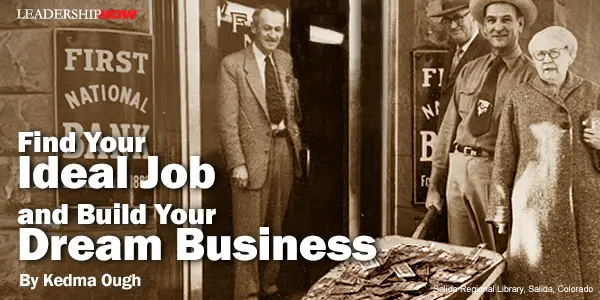
IS IT POSSIBLE to have your cake and eat it too? If there was a way to find your ideal job and build your dream business, would you consider both? Most people see this dichotomy and feel that they need to choose one dream over the other. The reality is that you can have both dreams so long as each doesn’t harm the other and enhances your lifestyle. Having worked with more than 10,000 entrepreneurs, innovators, inventors, hobbyists and side hustlers, they often struggle with when it is appropriate to leap from the job environment into the entrepreneurship maze. The presumption is that one has to sacrifice entrepreneurial dreams in order to be successful at a specific career choice. The truth is that you can have both and I strongly encourage aspiring employee-preneurs to review the following five reasons to consider maintaining your job in the first few years of building your business. 1. Learning from Both Work Environments: When you work as an employee and have a side entrepreneurial business, you can learn from both environments and both environments can benefit from each other. Often the entrepreneurial pathway is a lonely pathway and sole-preneurs in particular find themselves trying to navigate, learn and network to gain knowledge while building their business. Realizing that you can gain education from both environments allows an opportunity for you to thrive as an employee and manage a successful side hustle. 2. Business Ownership Strengthens Your Employee Net Worth: In most positions you rarely get the opportunity to experience the functions associated with the roles of a Chief Executive Officer, Chief Financial Officer, and Chief Marketing Officer, as well as manage the day-to-day requirements for customer engagement and retention. As a result of limited job functions in a large corporate environment, it doesn’t give you the full breadth of work involved in successfully managing an enterprise. By exploring the entrepreneurship maze you will quickly immerse yourself in all these functions, which will give you a better picture of the business itself, as well as an appreciation for the company that employees you. 3. Position Yourself with a Better Financial Portfolio: Quitting your job and then applying for a small business loan is a recipe for disaster. Often lenders expect borrowers to be fully collateralized. Having a successful employment position strengthens your probability of obtaining a loan or line of credit. While there are a lot of targeted small business funds that don’t require full collateralization, obtaining funds from your financial institution will be challenging if your debt to equity ratio does not meet their criteria and you don’t have a secondary source of income they can secure against the loan. In addition, being employed allows you the flexibility of investing in your small business without the stress of adding more debt into your current financial portfolio. Having the availability to set aside a few hundred dollars each month towards your business is significant when you have to consider paying for licensing, website development, social media support, etc. 4. Don’t Put Your Financial Eggs in One Basket: Diversifying your income allows you to mitigate financial risk and maximize your ability to make more money. Most people rely on their employment position for sole source income and if that position is compromised they may have a difficult time replacing those funds in a short period of time. Creating other opportunities to generate more money provides an additional financial cushion for investments or as an emergency fund program. The key is to target business concepts that don’t impose too much time on your part but produce a sizable financial return on your investment. Examples may include selling products online, starting a consulting business, or purchasing a semi-absentee franchise opportunity. 5. There Is No Need to Rush the Process: Most entrepreneurs believe they have to rush things to launch a company because they may lose out on the business opportunity. This may actually be a recipe for disaster. Rushing into a business concept without a proper feasibility review including competitive research, market analysis, and customer input is rushing to an unproven plan. Spending time building the foundation of the business allows for validation and a chance to identify the strengths, weakness, opportunities and threats of the proposed concept. Once the business has reached a certain consistent income you can decide whether to leap into the business full-time or hire others to manage the business. Ironically many of the Fortune 500 companies today began with entrepreneurs that started their business concept while working for an employer and then transitioned to their business slowly. Skin in the game does not mean you have to quit a job to explore a business. It means you have to be willing to invest time, money, or both in order to build your side hustle into a fledging small business operation. The great news is you don’t have to sacrifice either opportunity to benefit from both opportunities. You can have your cake and eat it too.  
Posted by Michael McKinney at 05:33 PM
07.25.19

How Innovation Is Completely Different in Established Organizations Than in Startups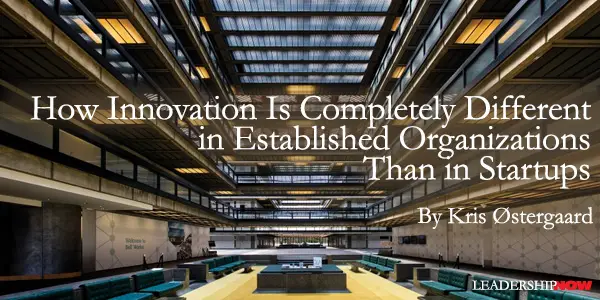
WE LIVE IN the age of the entrepreneur. New startups appear out of nowhere and challenge not only established companies, but entire industries. Where unicorns were once mythical creatures, the word unicorn now refers to the startups that have a value of at least $1 billion, and there are more than 370 of them worldwide. In 2018 alone, 53 unicorns were added to the list. Established organizations of a certain size and age, sometimes called “legacy organizations,” are stressed by the entrepreneurial successes. Their greatest fear is no longer their closest competitor, but the startups which, although they live in metaphorical garages and have hardly taken off, have an innovation power that established organizations can only dream of possessing. Still, no matter what great strides the innovative startups make or how much airtime they’re given by the media, innovation in startups is completely different than innovation in established organizations. The bad news for established organizations is that innovation for them is much more difficult than it is for startups. The most important job for startups is to focus on their (probably one) product and to subsequently scale up. Established organizations have to entertain many more considerations with their complicated product portfolios and business structures. The good news for established organizations, however, is that nobody is more likely to succeed than they are in their innovation efforts. Unlike startups, established organizations have tremendous resources. They have money, customers, data, employees, suppliers, partners, and infrastructure -- which put them in a perfect position to transform new ideas into concrete, value-creating, successful offerings. The Three Tracks of Innovation Many established organizations commit the mistake of engaging in innovation as if it were a homogeneous process. But innovation in established organizations must actually be divided into three different tracks: optimizing, augmenting, and mutating innovations. All three are important. There’s no one singular type of innovation that’s better than another. And, unlike the startups, established organizations must execute all three types of innovation at the same time. 1. Optimizing innovation: Improving the past. Optimizing innovation makes up the majority of what established organizations already do today. And they must continue doing so. Optimizing innovation is, simply put, the metaphorical extra blade on the razor. When the razor manufacturer launches a new razor that has not just three, but four blades, to ensure an even better, closer and more comfortable shave, only to announce one or two years later that it’s now launching a razor that has not only four, but five blades, that is optimizing innovation. This is where the established player reigns. No startup with so much as a modicum of sense would even try to beat the established company in this type of innovation. Continuous optimization, both on the operational side and the customer side, is good and important -- in the short term. It pays the rent. But it’s far from enough if the established company wants to continue to be a leader three to five years from now because there are limits on how many blades a razor needs. Each additional blade generates a bit less value than the previous one. Essentially, optimizing innovation improves upon the past. But startups are inventing the future. To match their entrepreneurial innovation power, established organizations must also prepare for the future and, ultimately, learn how to invent the future. 2. Augmenting innovation: Preparing for the future. To prepare for the future, the established players must engage in innovative augmentations. The digital transformation projects that more and more organizations are initiating can typically be characterized as augmenting innovation. It’s about upgrading the organization and its core offerings and processes from analog to digital. Or, if organizations were born digital, they may have had to become “mobile-first.” Perhaps they’ve even entered the next augmenting phase, which is to become “AI-first.” These augmentations are not small matters. They require great technological conversions. But technology may, in fact, be a minor part of the task. When it comes to augmenting innovation, the biggest challenge is most likely culture. Where startups have the advantage in building cultures from scratch that fit the times in which they originate perfectly, established organizations, who have had decades or even millennia of history, typically have created cultures in which there’s a preference to maintain the status quo. But if they hope to match the startup innovation power, they will need to transform their cultures to ensure their employees all thrive in constant change. 3. Mutating innovation: Inventing the future. Finally, established organizations also need to invent the future through mutating innovation. The business that maintains or exceeds its level of success 10, 20, and 30 years from now will have mutated. Whatever is currently at the core of the company today, making up the majority of the top and bottom lines, won’t remain the same in the long run. Mutating innovation requires a bold focus on experimentation into what isn’t yet understood. This is where the successful startups have excelled -- taking what exists and challenging it to either create something new with more value or open up to new target groups. For established organizations, this innovation track is difficult because it essentially challenges their identities. Therefore, mutating innovation cannot thrive inside a company’s core, but needs to be taken outside to the core organization’s edges. Tools to promote mutating innovation can include establishing labs or X-divisions. Alphabet has excelled in this approach, but other legacy companies are also increasing their experimentations. DIY chain Lowe’s, for example, is building 3D printers that print in zero gravity, thus opening up entirely new markets for themselves. Japanese airline ANA commissioned a global competition via the XPRIZE Foundation to create the future of travel that has now resulted in targeting the next big market: Space. As game-changing innovation is at the core of these efforts, both startups and established organizations can find common ground in working together. The established companies want access to the startups’ technology expertise, while the startups want access to the established companies’ customers and data, this can be a match made in heaven. Becoming the Innovation Champions of the Future Ultimately, if startups turn to scale-ups and succeed, they’ll fast become established organizations with very complex systems, requiring them to change their innovation strategies and entire organizations to remain successful. For Alphabet, even though the company is only 20 years old, this has already happened twice. It moved from a search engine to advertising to spawning off autonomous vehicle and health care companies that may turn into the new cores of the organization. Similarly, Apple is in the process of transforming from hardware into an entertainment company, and Amazon, perhaps the master of mutation, continuously adds new layers to its complex structure. For the legacy organizations of the world, they must learn from these examples, dare to challenge their status quo cultures, and ensure that they can engage in optimizing, augmenting and mutating innovation at the same time if they are to become innovation champions of the future.  
Posted by Michael McKinney at 01:27 PM
07.15.19

Jerry Colonna on True Grit and Other Advice for Leaders
JERRY COLONNA helps start-up CEOs make peace with their demons, the psychological habits and behavioral patterns that have helped them to succeed—molding them into highly accomplished individuals—yet have been detrimental to their relationships and ultimate well-being. In Reboot: Leadership and the Art of Growing Up, he does just that. He states that much of what he has learned about growing up came from learning to lead. Reboot is a peak into his life and the lives of leaders as they come to terms with who they are and what is holding them back. It’s like listening to a coaching session. Who we are shows up in our leadership. Sometimes, we use the organizations we lead to make ourselves feel better about our unresolved issues. When we don’t like what we see, we have to be honest and ask ourselves, how have I been complicit in creating the conditions I say I don’t want? In Reboot, he says things like: The back of the warrior is strengthened by knowledge of knowing the right thing to do. The soft, open heart is made resilient by remembering who you are, what you have come through, and how those things combine to make you unique as a leader. On learning to lead yourself he says: Learning to lead yourself is hard because it requires us to look at the reality of all that we are—not to fix blame on ourselves but to understand with clarity what is really happening in our lives. Learning to lead yourself is hard because it is painful. Growth is painful; that’s why so few choose to do it. A client tells him, “It’s like this—if I’m not panting, I feel like I’m not working.” He responds with: There it is. That same old haunting belief system. Run faster and faster, telling oneself that the way to be is to do; do more, faster, and just maybe you’ll outrun war, cancer, and the other demons that cause you to doubt your worth, your lovability, and your own voice. Colonna challenges leaders to show up as you are. When we stop the bullshitting, the pretending that we’re crushing it, that we’ve got it all figured out, we run the risk of being overwhelmed by the realities of all that we carry—the burdens we’ve convinced must remain secret to keep us and those we love safe, warm, and happy. But the spinning prevents us from being who we really are. You might as well tell me who you are because if you don’t, I’m going to invent things, and those things will stand between us, keeping us from being close. His thoughts on grit are illuminating. He begins by telling us what grit is not: False grit is brittle. It’s the sense that we are nothing if we can’t take a punch. In fact, we define “taking a punch” as the ability to not feel pain when we are pinched. False grit is dangerous. It feeds a stubbornness that, in turn, can feed delusion. We mistake the tendency to delude ourselves that our relationship will improve—our companies will succeed—if only we double down on our old patterns, grip the steering wheel until our knuckles whiten, and bear down. Stubbornness is not the hallmark of the warrior. Leaders who persist out of stubbornness, believing themselves to be gritty, are, at best, delusional and, at worst, reckless. On the other hand, true grit is kind. True grit is persistent. True grit persists not in holding on to false beliefs against all evidence but in believing in one’s inherent lovability and worthiness. True grit is the leader believing in the team’s purpose, its capacity to overcome obstacles, and the relevancy of the cause. True grit acknowledges the potential of failure, embraces the fear of disappointment, and rallies the team to reach and try, regardless of the potential of loss. 
Posted by Michael McKinney at 01:05 AM
03.15.19

Leading Views: Entrepreneurs Are the Heroes of Creative Destruction
In this chronological account beginning with the American Revolution, the genius of America’s innovative success is not only its tolerance of but also its penchant for creative destruction. Though sometimes painful, it is the driving force of economic progress. The authors talk not only of the familiar product innovation but also America’s process innovation—innovation in management and organizing production. Entrepreneurs drawn from every level of society are the primary drivers of this creative destruction. Associated with openness and opportunity, America produces and draws in more entrepreneurs than anywhere else. Entrepreneurs are the heroes of creative destruction—the people with the ability to feel the future in their bones and bring it into being through sheer force of will and intellect. Entrepreneurs drive long-term growth in productivity by pursuing their dreams of building a business, launching a product, or, human nature being what it is, making a fortune. But they are seldom the easiest of heroes, or the nicest. They are almost always guilty of what might be termed imperialism of the soul: they will sacrifice anything, from their own peace of mind to the lives of those around them, to build a business empire and then protect that business empire from destruction. Great entrepreneurs are never at rest; they must keep building and innovating in order to survive. They are also prone to what Norwegians call Stormannsgalskap, or the “madness of great men.” 
Posted by Michael McKinney at 12:54 AM
02.13.19

Finding Your Flywheel
GREATNESS NEVER HAPPENS in one fell swoop—no single action. It is the result of a series of correct actions that build on each other. Jim Collins likens it to turning a giant, heavy flywheel. In Turning the Flywheel, he describes the process: Pushing with great effort, you get the flywheel to inch forward. You keep pushing, and with persistent effort, you get the flywheel to complete one entire turn. You don’t stop. You keep pushing. The flywheel moves a bit faster. Two turns … then four … then eight … the flywheel builds momentum … sixteen … thirty-two … moving faster … a thousand … ten thousand … a hundred thousand. Then at some point breakthrough! The flywheel flies forward with almost unstoppable momentum. The flywheel concept was first introduced in the bestselling Good to Great. In Turning the Flywheel, Collins shares practical insights and clarity about the process. You can see it at work in successful organizations, but the trick is finding your flywheel. While it your flywheel may be similar to another organization’s flywheel, “what matters most is how well you understand your flywheel and how well you execute on each component over a long series of iterations.” Collins lists seven essential steps to finding and capturing your flywheel. Collins explains the flywheels of Amazon, Vanguard, Intel, Giro Sport Design and others. Giro’s flywheel is illustrated below. As with all proper flywheels, each step or action in sequence is the almost inevitable consequence of executing the step before it. So, in the case of Giro, by creating a great bike helmet that elite athletes want to wear, it naturally inspires weekend warriors to wear it, which in turn attracts mainstream customers, which builds brand power and allows you the resources to invent more great products. And the flywheel turns faster and with more power.
If you understand your flywheel’s underlying architecture as distinct from a single line of business or arena of activity, you can evolve, expand, or extend your flywheel in response to changes in your environment. That is to say the underlying logic of your flywheel—what your organization is doing. If you understand that, you can apply it to other areas. Some Rules The very nature of a flywheel—that it depends upon getting the sequence right and that every component depends on all the other components—means that you simply cannot falter on any primary component and sustain momentum. Collins also makes it clear that a flywheel operates within a context—a framework of principles that great organizations adhere to. The framework has four stages: Stage 1: Disciplined People
The flywheel principle operates at the pivot point from Disciplined Thought into Disciplined Action. Collins explains each stage in detail and the principles that apply to each like Level 5 Leadership, the Hedgehog Concept, 20 Mile March, and Fire Bullets, Then Cannonballs. But I found this observation interesting: An overarching theme across our research findings is the role of discipline in separating the great from the mediocre. The only legitimate form of discipline is self-discipline, having the inner will to do whatever it takes to create a great outcome, no matter how difficult. When you have a disciplined people, you don’t need hierarchy. When you have disciplined thought, you don’t need bureaucracy. When you have disciplined action, you don’t need excessive controls. When you combine a culture of discipline with an ethic of entrepreneurship, you create a powerful mixture that correlates with great performance. Every entrepreneur should read this because it organizes your decisions around a principle that compounds your efforts. Turning the Flywheel is a short but necessary read to help you understand your business and what can and will make it successful. Executing well on a well thought out flywheel will give you years—even decades—of success. More importantly, if leaders communicate their organization’s unique flywheel so that everyone at every level understands it, it will bring clarity and purpose to each individual’s work. It provides tangible evidence as to their part in the organization’s success. 
Posted by Michael McKinney at 08:12 AM
02.04.19

Simple Techniques to Overcome Negative Emotions When Negotiating with Others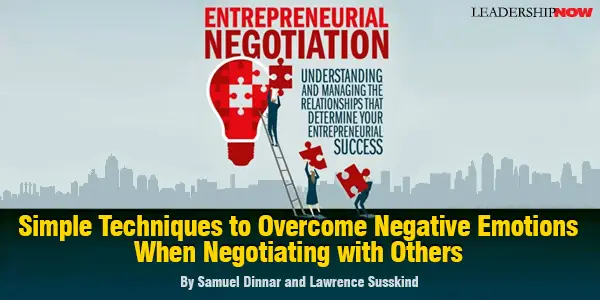
A KEY PREDICTOR of entrepreneurial success is a leader’s ability to manage relationships with investors, employees, and customers. Relationships are negotiations. We all negotiate. How well we learn to negotiate can be the difference between success and failure.
Here we will look at one aspect of successful negotiating: our emotions. The mishandling of emotions – especially tension and mistrust – is a major source of errors when negotiating. It can lead to miscommunication, misjudging the other party’s motives, inability to reach consensus, and more. In our book Entrepreneurial Negotiation, we explain that the best way to diffuse negative emotions is to prevent them from escalating in the first place. Diffuse Tension Before It Escalates At the beginning of every negotiation, there is a natural tension in the air. The higher the stakes, the higher the tension level. To diffuse it, open by conveying your sincerity and warmth with a handshake, eye contact, and a smile, as appropriate. Other ways of reducing tension in the first few minutes are sharing airtime while projecting genuine interest, showing respect and asking for agreement on some small initial ground-rule (e.g., use of first or last names, seating arrangements, etc.). A 2004 experiment using sociometric badges in a mock negotiation (between a corporate vice president and a middle manager) demonstrated that “tone of voice” used by participants in the first five minutes predicted more than a third of the variation in the objective and subjective outcome of a negotiation. They also found that turn-taking dynamics (who speaks when) had a strong correlation with the subjective value levels reported after the negotiation. Still, other studies showed that similarity, also called affiliation, is a primary factor that influences personal human connection – the building of rapport between individuals. Rapport reduces stress and is the best predictor of success in relationships. As a negotiation proceeds to more difficult topics, good negotiators maintain a relaxed tone (with the appropriate level of seriousness) while respecting their counterpart’s autonomy and status. The Power of Humor, Stories, and Metaphors Several additional tools that are often used to reduce stress are storytelling, metaphors, and humor. The appropriate use of humor, especially, can serve as a release valve for negative emotions such as anxiety, suspicion, and anger, and can create room for people to put things in perspective. Humor can also serve as a way of acknowledging the absurdity of the moment, where parties have inadvertently locked themselves into extreme positions. Humor does need to be used carefully. If a party doesn’t understand an attempt at humor, they may be left wondering if the joke is on them. If they feel as if they are the target (or that they are being taken lightly), it will most likely make the situation worse. Finding the right balance between humor and serious intent can make it easier to deal with escalating competitive behavior. Stories have the power to convey an important idea, stimulate a strong emotional response, and allow a release of political or interpersonal tension. They help to shift everyone’s focus from the tension in the room to the tension in the story. At the conclusion, when the story’s tension is finally released – both the listeners and the storyteller experience a stress-reducing feeling. Our brains react to stories the same way they react to true events. Using metaphors is also effective. For example, in negotiating the break-up of a business, framing the situation as a pile of cash to be divided creates a “divide the pie” metaphor. This is likely to induce a win-lose mindset. Using a story about a “cash cow” might shift the focus to a living creature that cannot be divided, but if taken care of will produce dividends over time. This second framing metaphor would more likely induce a collaborative discussion of how to share responsibilities and allocate future profits. Apologize Quickly and Sincerely f you realize you have done something that has hurt the other side, you should issue an apology immediately. It is rarely to your advantage to provoke feelings of fear, anger or resentment. A sincere apology can often restore a better working context. Apology is a social ritual that shows respect and empathy to the offended person. While you cannot undo a mistake, an apology can help the other side move on. This is the opposite of what happens when a person is emotionally triggered. Experiments show that receiving an apology reduces heart rate, breathing rate, sweat levels, facial tension, and blood pressure. Apologizing quickly and sincerely shows that you take responsibility for your actions. On your side, it can also prevent a buildup of remorse or shame caused by the fact that you hurt someone or simply as a result of having made an error. It is not easy, and quite humbling to apologize, but when done correctly it projects the inner strength of someone who is confident and aware of the feelings of others. Even when you apologize immediately, don’t rush things. It takes time for impacted emotions to wash over the other side. The body needs time to recover and to switch from fear, anger, and anxiety to empathy and compassion. Be present and attentive. Accept the silence as OK, and don’t move on prematurely. You may need to repeat your apology, since it may not have been fully heard or absorbed the first time. Focus on your counterpart’s reactions. Wait for them to indicate that it is OK to continue. Some mistakes are minor, and it will be easier for the other side to recover from these, even without an apology. Some will require both sides to cool off before continuing. After you have apologized and demonstrated your sincere intent to remedy the situation, you may want to revisit the item that was on the agenda when you made the mistake initially. Ask for a “do-over.” This is the ultimate “detect and respond” response: an “on-the-spot” apology that is accepted, coupled with permission to return to the negotiation. Negotiations are fraught with tensions. Learning to reduce tension and negative emotions creates a better outcome for everyone.  
Posted by Michael McKinney at 11:43 AM
11.19.18

William Donaldson on Entrepreneurial Leadership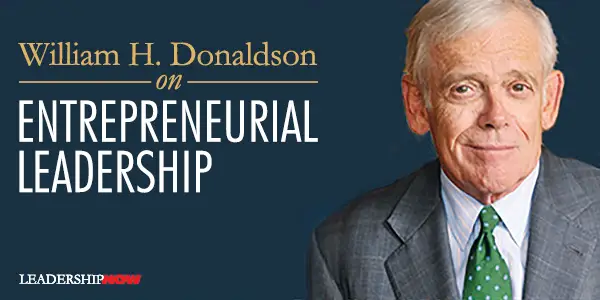
W Donaldson and Karl Weber extract relevant lessons for leaders in Entrepreneurial Leader. The thread that runs through his career is the entrepreneurial mindset. That mindset is “about the application of creative thinking and prudent risk-taking to build innovative, long-lasting organizations in any sector of the economy.” There are leaders and there are entrepreneurs, but not all leaders are entrepreneurs, and not all entrepreneurs are leaders. Simply put, I believe that entrepreneurial is a mindset—a way of thinking—and leadership is a way of acting. Entrepreneurial leadership, then, describes the way such a leader behaves. The case method he experienced at the Harvard Business School, showed him that “in many cases, the deeper you delve into a problem, the less obvious the answers are.” This realization is empowering because “since nobody really knows the one perfect solution to the kinds of real-life challenges organizations face, it’s important to have the courage to ask questions, to propose answers, to challenge assumptions, and to experiment—all of which are key elements of the entrepreneurial drive.” As founding dean and professor at the Yale school of management, he taught a course on entrepreneurial leadership. He focused on the personal characteristics of the leader. “Of course, an entrepreneurial leader needs to know about subjects like financial management, competitive strategy, market analysis, and the like. But I think those topics are distinctly secondary. More important are the human qualities that the entrepreneurial leader brings to the job—the ability to see the world through fresh eyes; the ability to pay attention to both the big picture and the small details that define a particular situation; a high degree of personal energy, optimism, and a sense of fun; the readiness to shape and define the system in which he or she operates rather than being controlled by a system someone else has created; and, most important, a strong sense of integrity.” By integrity, he means that they transcend themselves. They look beyond their ego. They remain true to the vision and commit to the value of individuals. He notes that an entrepreneur is not a gambler. “The smart entrepreneur uses careful planning, intelligent strategy, and lots of hard work to minimize the risk as much as possible.” Effective leaders must be entrepreneurial—which means getting things done, regardless of the obstacles. I found this comment especially useful as it speaks to the mission here at LeadershipNow: In the business arena, entrepreneurial leaders must think and behave as if they own the company—whether they do or not. Entrepreneurial leaders must define systems rather than be defined by them; they must adopt an ownership mentality. They understand that they must take ownership of their choices, including the smaller, day-to-day decisions they make. They must take full responsibility for them rather than attributing them to “the system” or “circumstances.” Entrepreneurial leaders also think continually about the big picture—the broader goal that everyone in the organization is supposed to be working toward—and strive to be guided not by short-term gain or personal profit but by long-term objectives that help everyone. Furthermore, entrepreneurial leaders find ways to encourage everyone in the organization to think and behave in this way, and create circumstances that help them do this. The behind-the-scenes look at the roles he has taken on throughout his life—especially the rationale behind and the building of Donaldson, Lufkin & Jenrette—is instructive. The range of his life and career demonstrate the broad relevance of the principles he describes in this book and makes for a fascinating read. 
Posted by Michael McKinney at 12:43 PM
11.14.18

The 8 Elements of Punk Rock Business
O The title of Jeremy Dale’s book, The Punk Rock of Business, comes from a comment Bono made to Oprah about a project Dale was working on with him for Motorola. Dale and his team had performed the impossible and Bono said, “They are the punk rock of business: no long introductions, three beats and you’re in. They say they are going to do something, and then it just gets done.” Using that as an inspiration, Dale has taken it to mean so much more. Punk is an attitude. It’s a fight against apathy and complacency. “I’m not okay with the current status quo. We’re into disruption.” Many businesses these days are clogged up by bureaucracy that thwarts innovation, slows down creativity, and encourages mediocrity. I hate mediocrity. I’d much rather have spectacular success or fantastic failure. I believe mediocrity occurs far too often because too many people in business, particularly those in middle-management roles, are far too cautious, pessimistic, and more concerned about protecting their jobs rather than striving for greatness and being everything they could be. They are fearful of putting their heads above the parapet, so they take a play-it-safe attitude and come up with the conservative, tame, and expected proposals. Dale has distilled the punk rock movement to eight elements. These 8 elements of Punk Rock Business were at the heart of punk rock music, movement, attitude, fashion, and culture. Elements that are wanting in many organizations. Element 1: Have a Cause “Punk was all about wanting something better, being clear about what that was, and making that their cause.” Have a point of view. Find something you’re passionate about and then inspire your team to deliver it. An organization’s mission statement is meant to direct every single decision. A mission statement may not be enough. You may need to create a manifesto to add substance and emotion, creating a story around the mission statement. “We should be committed to being a lighthouse brand; that is, one who shines brightly, whose position is fixed so that people can navigate their world trusting in us and our position on things.” Well put. Element 2: Build a Movement “Punk was attractive to like-minded people, and it galvanized that segment of the youth. Punk, more than music, was a mindset, and that attracted people.” It’s all about the people. The followers make the movement. You must get other people on board. Show your commitment to them and the mission by showing up. This is where you bring your emotional brain and not your rational brain. Element 3: Create New and Radically Different Ideas “Punk was completely different—never seen before jaw-dropping creation that exploded into our consciousness. No one was ambivalent to punk; you loved it or hated it.” It’s about creating new, different, and better ideas. After all, that’s what leadership is. Punk provided an avenue to express their frustration with the dead-end society that they saw at the time. “Never before had music been played at anything like two hundred beats per minute. Never before had music been played so loudly or aggressively. Never before had the lyrics to the songs been so politically charged or laid siege to taboo subjects.” Begin by finding out what’s different about what you’re doing. What problem are you trying to solve? Radical ideas come from teams. And when they do they need to be brought to life by showing, not telling. Radical ideas are targets and so need to be protected. “Every project should have a vision and some nonnegotiables. The nonnegotiables are so important, because not only do they prevent the willingness to compromise, they also act as the catalyst for intelligent people to seek creative solutions when the inevitable challenges arrive.” Element 4: Drive Speed and Action “Punk was three beats, and you’re in.” Go for it. “When time is tight, great things happen.” You don’t always have to be right. “Decision-making is a portfolio. Not every decision needs to be correct.” The momentum is the important thing. Element 5: Say It as It Is “Punk lyrics came with a contagious honesty.” No nonsense. You have to say it like it is—but constructively. Sometimes you have to call others out, and sometime you must call yourself out. Don’t leave people wondering what you think. Speaking plainly saves time, bring clarity, and sets the performance bar where you want to set it. Element 6: Be Authentic “Punk gave people permission to be themselves.” Probably the only rule of being punk is: “to be yourself and be comfortable being who you are.” Surround yourself with confidants who will hold you accountable and call you out when you are being a fraud. Element 7: Put Yourself Out There “To be punk you had to make a very visible and belligerent statement; it required you to put yourself out there, say ‘this is me,’ and invite criticism. It was far more important to just give it a go, rather than to get it perfect.” Grab every opportunity to challenge yourself. Be the first to volunteer. You will be criticized. Get used to it. “You will not always get it right, but my experience is that the impact you have when you do get it right far outweighs the embarrassment when you don’t.” Are you a participant or a spectator? Element 8: Reject Conformity “Punk pressed the reset button.” Nonconformist. “However, it wasn’t just its nonconformity, it was the extent to which it didn’t conform that was shocking for many.” Some norms are pointless and irrelevant. “Today’s corporate world is full of mediocrity, slowness, politics, false praise, and people too scared to say it as it is. More and more employees are disillusioned with lukewarm leadership that makes their jobs dull and boring and constrains their creativity, imposing limitations rather than empowering them.” Don’t take yourself too seriously. “Get over the show, get over your ego, and react based on the quality of work, not the superficial stuff that doesn’t matter.” Joey Ramone said they started a band because in 1974 everything was overproduced. “Being overproduced and perfectly organized kills the lifeblood that spontaneity brings.” Humility is the X-Factor “Punk by its very nature is aggressive and in your face.” Humility keeps you out of trouble. “Punk doesn’t need to be aggressive if you apply a degree of care and humility. If people see that you are fundamentally a good person, whose heart is in the right place, whose motives are pure, who has charm and charisma, who isn’t arrogant or conceited, who cares about people, and above all else is human and has humility, then you can apply all eight elements without worrying if you’re going too far.” Dale adds fifteen more key requirements that are needed to implement a punk rock attitude in business. Unfortunately, I have not conveyed in this commentary the great stories that are used throughout to illustrate the 8 Elements of Punk Rock of Business. They are engaging and entertaining and really help to develop the concept. Well worth the read. The book provides a much-needed perspective on business and leadership in a very unconventional way. 
Posted by Michael McKinney at 07:14 PM
10.15.18

Dear Founder
W Maynard Webb is a Silicon Valley veteran and investor. Behind all of these letters is real-world experience from his days at IBM, eBay, Yahoo, LiveOps, Gateway, Bay Networks, and Quantum. They are organized to follow the trajectory of a company’s life cycle from getting started, getting to relevance, getting to scale, to finally leaving a legacy. Being a founder is complicated, and with each step in the life cycle, the success stories become fewer and fewer. Webb’s wish is that these letters will help you and your team through the tough issues that most founders inevitably face. Too often, Webb finds that founders set the bar too low. It’s uninspiring, and the company doesn’t “achieve the destiny it’s aiming for.” “I’ve learned,” says Webb, “that it is better to aim very high and not quite achieve perfection than to nail every goal and deliver mediocrity.” He encourages, “We are all capable of more than we think we are. Dream big, and execute bigger. If you are willing to dream and then work hard and execute well, you can achieve more than you ever imagined.” Fundraising while exhausting, can make you better. “Fundraising is a lot like sales, only this time you’re not selling a product but rather shares in your company…. It can offer a window of self-reflection and a chance to tighten your story and focus on the important drivers of your business.” There are many letters on the nuts and bolts of growing a business, but not surprisingly, many of the letters deal with the human side. It’s all about people. Here are some excerpts from several of the letters: When You Need to Delegate “Effective delegation means that you know that the task/project will get done with the results that you expect. At the outset, this means that you have to: “Assess the capability and willingness of the team to do the task. Often, people will volunteer for a cool assignment, but can/will they really do it? “Communicate what success looks like to the people you are delegating to. What is the timeline, quality, etc.? “Ensure they know that if they encounter problems, you are there to guide them. Overall, you are still accountable for the results. Delegation is not abdication. “Establish checkpoints to monitor progress, so you don’t get any nasty surprises at the end. “When the team delivers, celebrate their success. “The more confidence you have in a team or person, the less structure you need to make delegation work.” When You Are Overwhelmed “The important thing is to realize that it is a momentary state. By shifting into action, you can get rid of this uncomfortable feeling. Once I realize that I am feeling overwhelmed, I don’t need to actually fix everything to get rid of the overwhelming feeling; I just need a plan that I believe in and that I can start executing.” When You Are Confusing Hubris with Boldness “Of course everybody that comes in thinks they have a winning strategy, but when someone truly has conviction, it shows. How? It’s when someone can crisply articulate the vision, the value proposition, the market, and the potential. They have clarity on what their next steps are and what will be done with the money. Rather than downplay competitors as dumb and naïve, they explain what the strengths of each are and why these strengths will make the difference for them to outcompete this new startup. “Here’s the one thing that signals a bold attitude that might be more counterintuitive: being secure enough to identify the parade of horrible things that can go wrong.” When You’re Accused of Working Too Much “In staring a company, the unfortunate reality is that there’s no such thing as balance. Taking an idea to greatness requires extreme—Herculean—efforts. “Sometimes these trade-offs will be worth the cost, and other times they won’t be. If they are not, don’t commit to doing your job halfway. “Our work and personal lives often collide, and they will only continue to do so. The best way to make it all work is not to silo off these distinct parts, but to weave them together into a custom tapestry. If you do that, and if you are truly doing what you love, it trumps the desire for balance and achieves something better, something magical.” When You Self-Impose Limits “When you create limits that don’t really exist, you are justifying where you are. And where you are is never as great as where you could be. “Generally we put more limits on ourselves than any outside force ever can. “If there is a recipe for success, I believe that it is this: Get out of defense mode and go into wonder mode.” When You Receive Public Criticism “I’ve come to realize that getting input—good or bad—is a blessing. It gives you invaluable information on how you are doing, and more importantly, how you can do better. “So what do you do when you’re on the receiving end of critical reviews or negative comments? First of all, congrats—this is validation that people care about what you’re doing.” Other letters include: When you are selecting a co-founder
Of Related Interest: 
Posted by Michael McKinney at 12:07 AM
08.16.18

Straight Talk for Startups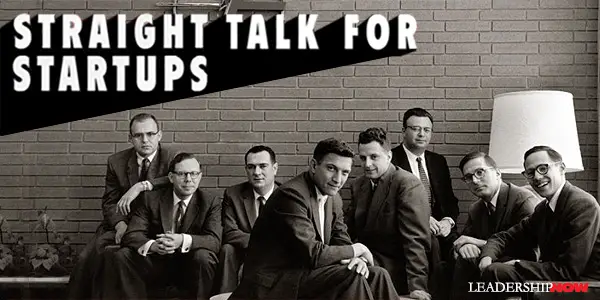
E Randy Komisar and Jantoon Reigersman bring decades of startup experience to help you beat the odds. In Straight Talk for Startups they offer 100 insider rules to bring clarity and a dose of reality to the entrepreneurial process. So whether you’re thinking of starting a business or are in the middle of managing one, this book will help to avoid (are correct) rookie mistakes. Komisar and Reigersman begin by telling you what matters and what doesn’t. Before you quit your job, here are a few things you need to think about: It’s hard. Because money is abundant, “it’s no surprise that the competitive landscape becomes crowded and non-economic.” It’s not uncommon for your competition to sell below cost in order to buy customers with their capital. And employees tend to act more like mercenaries than comrades in arms. Try to act normal. “There is nothing normal about being an entrepreneur.” I loved this line: “Venture capitalists have one of the greatest jobs in the world. They get to sit across the table from passionate strangers who hallucinate the future for them.” They advise that when selling your idea: “Don’t let them know you are one of those precious lunatics hell-bent on changing the world until you’ve gotten to know them better. You don’t want to scare them off right at the start.” Aim for an order-of-magnitude improvement. You’ve got to give people a really good reason to move from where they are quite comfortable to where you want them to be—a loyal customer. An order-of-magnitude of ten times is the minimum. Beyond that you improve your odds of success. “If you try to thread the needle with an innovation that is just good enough, you may miss [the target] entirely. But if you shoot for an order-of-magnitude change, you may still be in the game even if you miss by half.” Most failure result from poor execution, not unsuccessful innovation. “Plenty of people confuse luck for skill. We flatter ourselves and find cause where there is none. The difference between skill and chance boils down to repeatability.” Timing matters. The elements need to line up. The authors identify six significant stages of development: Stage 1: Idea—develop your idea and assess its attractiveness
There is a method to the madness. Don’t get ahead of yourself. Great clarification: “The creative process is essentially an execution process, not a eureka moment.” Other rules include:
Komisar and Reigersman close by saying, Always ask why. Why this? Why you? Why now? Asking why will keep you grounded. Know why this venture is important to you. Why it should be important to others. And given the low probability of success for any venture, why it is nevertheless worth failing at. Of course you don’t want to fail; success is always preferable to failure. But if you fail, will you feel you wasted your time, or that you fought the good fight? If you are considering starting a business, you will do well to also read Randy Komisar’s The Monk and the Riddle: The Art of Creating a Life While Making a Living. 
Posted by Michael McKinney at 08:01 AM
06.29.18

Born to Build
A All of us are to one degree or another. We are born to build. Building something gives us meaning and purpose. For some though, it is a need that drives them every day. Building is a high-degree-of-difficulty task, but natural builders want the impossible assignment. They actually prefer the messiness, the problems, the barriers, the absence of supervision, the improvisation and the rush of a new customer breakthrough. You can build something on your own or from within an existing organization. But builders know how to create demand for their ideas. In Born to Build, Jim Clifton and Sangeeta Badal of Gallup—the people who brought you StrengthsFinder—have turned their attention to entrepreneurs and ambitions, self-motivated people that want to build something. They take a psychological approach to the subject to understand builders—who they are, what motivates them, and how they do it. With the Builder Profile 10 assessment included with the book, you can find out if you are a builder and what part you are likely to play. The skills and the mindset of a builder will help you no matter what career path you choose. Successful builders proactively develop behaviors that empower them to anticipate problems, overcome adversity, recognize opportunities, organize resources and take action to build something. Gallup has determined that there are three key players or roles in the development of an organization: The Rainmaker, the Conductor, and the Expert. When all three are present in an organization or a team, the likelihood of it breaking out and booming grows exponentially. It is rare that any one person is all three. So the idea is to find partners or create a team early on that will complement your type of builder. The Rainmaker: Aggressive, optimistic, risk-tolerant, Rainmakers measure success by profitability. They are self-confident and incredibly persuasive. They know how to energize and influence customers and employees with their vision of the future. A venture almost never works without this player. (38 years ago when I started my manufacturing business, I wish I would have brought a Rainmaker on board a lot sooner. We would have reached our goals much faster.) The Conductor: They possess great management talent and mainly focus on the operations of the venture. They know how to get everyone working together and take pride in finding the right people for key positions. They build the venture by building its people. Hard work energizes them. The Expert: Primarily focused on product development and research, Experts set a high bar and believe that being the best in your field is the organization's crucial distinction. Highly independent, discerning and quick-thinking, Experts never accept the status quo and constantly imagine new possibilities. They are part artist and part scientist. The mindset of a builder incorporates four keys to building: Creating Self-Awareness, Recognizing Opportunities, Activating on Ideas, and Building a Team. Creating self-awareness and building a team is where this book and its assessment really come into play. Through study and research Gallup came up with a list of 10 talents that influence the behaviors and explain the success of a builder. Every builder uses a mix of these 10 talents:
Your unique mix of talents will determine your role in the venture—Rainmaker, Conductor or Expert. Your dominate talents help to determine your building journey. “The way you are wired will influence not only what you build, but also how you build it. Your talents are the lens you use to look at the world. They guide how you frame problems and the solutions you generate for those problems, what you see as roadblocks and the methods you use to clear them, how you identify your goals and aspirations, and the route you take to fulfilling them.” Importantly, once you understand the way you are wired, you will see what kind of people you need to complement your talents in order to successfully create your vision of the future and build your venture. Although it’s a romantic thought, we never do it alone. 
Posted by Michael McKinney at 07:57 AM
05.18.18

Burn the Business Plan
I The highly-romanticized, high-tech startups that we read about and want to emulate are less than seven percent of all start-ups and they experience the highest failure rate of all business startups. Eighty percent disappear within five years. Most entrepreneurs never went to college, and most did not start their companies until they were well along in their careers. The average entrepreneur is nearly forty years old when he launches, and more than eighty percent of all new companies are stated by people over thirty-five. More entrepreneurs are between forty-five and fifty-five than any other cohort, and entrepreneurs over fifty-five now create more companies than those under thirty-five. And—another surprise—the chances of a new company surviving rises with the age of the entrepreneur. What these high-tech startups have in common with all other entrepreneurs is that they don’t follow a business plan. The detailed and rigid planning of your typical formal business plan is of little value once the business gets underway. Just as German Field Marshal Helmuth Karl Bernhard Graf von Moltke once observed, “No plan survives first contact with the enemy,” “it is rare,” writes Schramm, “to find an entrepreneur who reports that his business plan was of much use…. Entrepreneurs must learn to dance to the market’s ever-changing tempo and rhythm. Planning doesn’t help and is mostly a waste of time.” Microsoft, Apple, Facebook, Amex, Disney, GE, Walmart, and Google are just a few examples of companies that began without writing a formal business plan. To build a successful company, one has to be able to change direction as shifting facts and circumstances dictate. In my experience running a manufacturing company for over 30 years, Schramm is right on. While I believe that the basics of running a business and the type of mindset that is required can be taught or presented, I would agree that you can only learn by doing. “There is no time-tested body of knowledge that will improve the probability that a startup will be successful.” As Steve Wozniak, Marc Randolph, and many others have suggested, a great way to learn entrepreneurship is by working in a big company. “The average entrepreneur works for someone else for nearly fifteen years before starting his own business.” Many entrepreneurs who started their own careers in large corporations regarded them as critical to their subsequent success. Most importantly, they learned the culture of business, how big companies did or did not do a good job of serving their customers, and their customers’ continuously changing needs. Building a company takes time. Rather than flipping their companies, most successful founders work at it for the rest of their lives. When you begin everything changes. “While many aspiring entrepreneurs think that starting a company is all about one good idea, in fact, successful entrepreneurs know that their first idea was seldom what made their company successful.” And here’s something to think about: “Failure rates are considerably higher for companies that are started with the intention of a short-term sale.” Every startup has one CEO. The myth that two entrepreneurs coming together makes for a better company is just that, a myth. A realistic “look at the history of startups shows that every company, even those claiming multiple founders, had just one person who functioned as the ‘entrepreneur-in-chief.’ She is the person who sparked the idea, first articulated the vision for the company and brought others together; the person who functions as the company’s driving force, without whom the startup never would have happened.” Another reason success as an entrepreneur favors age is that “creating a new product or service is an organic process, one that is shaped by background, experience, and acuity of the innovator.” “The average age of an inventor awarded a patent is forty-seven. The reason? Innovation involves a synthesis of accumulated knowledge, much of it subconscious, that the inventor has absorbed and compiled over his life.” If you are aspiring to be an entrepreneur, you would be wise to read widely across many fields and disciplines. Innovators are curious and have a voracious appetite for learning. Schramm tells the stories of Dyson, Head, Kasbar, Stebbins and others who “weren’t even sure that what they were toiling to achieve was a ‘company,’ they were just sure that they had really good ideas. Other interesting ideas Schramm covers:
Burn the Business Plan is a fascinating and accurate look at what it means to be an entrepreneur. It should be required reading in business schools and by anyone contemplating a startup. Schramm tells interesting stories of entrepreneurial successes and failures all of which add to the value of this book. 
Posted by Michael McKinney at 04:13 PM
01.26.18

A Dozen Lessons for Entrepreneurs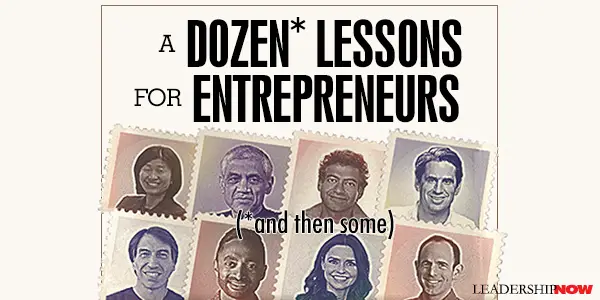
T For A Dozen Lessons for Entrepreneurs, Griffin has interviewed 35 people who have “seen more highly successful business launched than any other single group on the planet.” He offers 12 quotes from each followed by short explanations to provide clarity and context. The book is a real education that is worth taking the time to reflect on and absorb. You will get an experiential education from investors like Steve Blank, Marc Andreessen, Mary Meeker, Paul Graham, John Doerr, and Ben Horowitz. What follows are some of the thoughts that resonated with me: Eric Ries: “The mistake isn’t releasing something bad. The mistake is to launch it and get PR people involved. You don’t want people to start amping up expectations for an early version of your product. The best entrepreneurship happens in low-stakes environments where no one is paying attention, like Mark Zuckerberg’s dorm room at Harvard.” (p. 36) Sam Altman: “In general, it’s best if you’re building something that you need. You’ll understand it better than if you have to understand it by talking to a customer. Passion and a mission are more likely to exist if a business is providing solutions to problems that cause the founders personal pain. In other words, a deep understanding of a valuable customer problem and potential solutions to that problem is enhanced if the founders are themselves potential customers for the solution.” (p. 44) Sam Altman: “Eliminate distractions. The hard part of running a business is that there are a hundred things that you could be doing, and only five of those matter, and only one of them matters more than all of the rest of them combined.” (p. 48) Steve Anderson: “Ten years ago, you needed $5 million to start a business. Today, you need $70 and some coding skills.” (p. 53) Rich Barton: “It’s much more powerful long-term to make up a new word than it is to use a literal word. I also like to high-point Scrabble letters in my brands if I can work them in. They are high point because they are rarely used. A letter that’s is rarely used is very memorable. Z and Q are all worth ten points in Scrabble. X is 8. They jump off the page when you read them, and they stick in your memory as interesting.” (p. 73) Chris Dixon: “You’ve either started a company or you haven’t. “Started” means starting with no money, no help, no one who believes in you (except perhaps your closest friends and family), and building an organization from a borrowed cubicle with credit card debt and nowhere to seep except the office. It means lying awake at night worrying about running out of cash and having a constant know in your stomach during the day fearing you’ll disappoint the few people who believed in you and validate your smug doubters.” (p. 99) John Doerr: “Believe me; selling is honorable work—particularly in a startup, where it’s the difference between life and death.” (p. 102) Jim Goetz: Many of the entrepreneurs that we back are attacking a personal pain.” (p. 116) Paul Graham: “If you want to start a startup, you’re probably going to have to think of something fairly novel. A startup has to make something it can deliver to a large market, and ideas of that type are so valuable that all the obvious ones are taken. Usually, successful startups happen because the founders are sufficiently different from other people—ideas few others can see seem obvious to them.” (pp. 126-127) Reid Hoffman: “So many entrepreneurs are worried about protecting their precious ideas, but the truly valuable thing is that you’re in motion, you have momentum, and you are gathering all the necessary resources to make it happen.” (p. 158) Reid Hoffman: “The network of people around you I what extends your ability to be effective regarding expertise and reaching your goals. Put yourself out there and get feedback. Don’t be afraid to take a risk. Another huge thing to emphasize is the importance of your network. Get to know smart people. Talk to them. Stay current on what’s happening. People see things that other people don’t. If you try to analyze it all yourself, you miss things. Talk with people about what’s going on.” (pp. 160-161) Ben Horowitz: “Sometimes an organization doesn’t need a solution; it just needs clarity.” (p. 168) Vinod Khosla: “The single most important thing an entrepreneur needs to learn is whom to take advice from and on what topic. Ask different questions of different people, both those who have been successful and those who haven’t.” (p. 179) Keith Rabois: “As you get into the unchartered territory where you don’t actually have any intellectual background, you need perspectives from people who are very different from you. At that point, it’s actually quite valuable to have people who are diverse.” (p. 255) Keith Rabois: “First Principle: The team you build is the company you build.” (p. 254) Fred Wilson: “Reputation is the magnet that brings opportunities to you time and time again. I have found that being nice builds your reputation.” (p.302) 
Posted by Michael McKinney at 06:11 AM
01.22.18

Killing It! How to Run a Startup in a Healthy, Joyful Way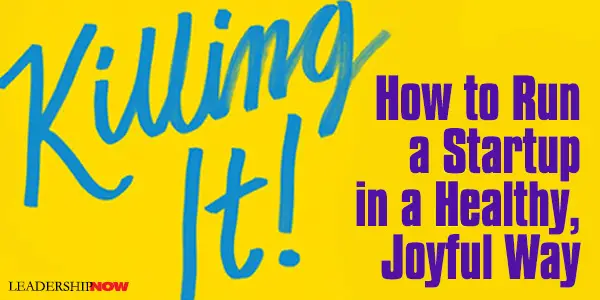
A Entrepreneurship has never seemed so popular as it is today no doubt because it is easier than ever to start a company. Especially in the tech sector, barriers to entry have fallen, and there is greater access to risk capital for startups. Steve Anderson, the founder of Baseline Ventures, said, “Ten years ago, you needed $5 million to start a business. Today, you need $70 and some coding skills.” It is a golden age for entrepreneurs. But with the implied success is a dark side that is rarely talked about. The cost is often the entrepreneur’s physical and mental health and the impact their work has on their family and friends. Sheryl O'Loughlin tackles this head-on in Killing It! The entrepreneur’s personal life is often the hidden cost of building an uber-successful career or business. Sheryl who has taught entrepreneurship at the Stanford Graduate School of Business understands the ups and downs of being an entrepreneur. She served as the CEO of Clif Bar, was the Co-Founder and CEO of Plum Organics and is now CEO of REBBL. In Killing It! she offers empathetic support for entrepreneurs with candid discussions about her own experience and those of other entrepreneurs she has known. Many people start a business without really knowing what they are getting into. Starting a business for money is a bad bet since around 95 percent of startups fail. There needs to be a real love for the problem you’re trying to solve. Professor, social entrepreneur and investor Will Rosenzweig, told Sheryl, “Many thought they were going to launch a business coming out of school, not necessarily to solve a problem, but the problem they were trying to solve was their own unemployment and livelihood.” Execution Once you get past the idea, execution is everything. “It’s this build phase that catches many entrepreneurs by surprise—after so much excitement; they’re shocked at how mundane it all is. Remember the Buddhist saying, ‘After enlightenment, the laundry.’ Oh, and how much laundry there is.” Sheryl says you have to make others love your business as well and connect to the company’s purpose—and it’s ongoing. You do that by inviting others to be part of the story. You help others to connect their personal passions to the company’s purpose. You and your team need to live the experience your customers have with the product. You need to be a leader that models love, compassion and care and hire people that can do the same. At the same time, love can blind you to realities. So “let reality in,” she cautions. “You don’t have to love every moment, but you do have to love enough of them.” Entrepreneurs believe they have to do it all. Show no weakness. But we do have weaknesses. We need to talk to each other. “When entrepreneurs don’t rely on one another, they don’t harness the power of possibility. Too often we approach our work from a mind-set of scarcity and not one of abundance—a mistake that holds us back. The entrepreneurial profession requires that a person be vulnerable in order to remain healthy, and it’s critical to have a space in your life with others that allows for that.” When it comes to running your own company, business and personal issues are all intertwined. Friendships Hang on to your friends. “Friendships are crucial for the emotional well-being of an entrepreneur, but they are often the first thing to hit the chopping block when things get busy.” There are three good reasons for this:
Risk-Taking I’ve risked it all is not a good strategy. “A skilled entrepreneur is the one who will assign risk to somebody else. The entrepreneur will that the resources when they are there. Would you go climbing without the proper gear? Probably not, and you shouldn’t approach business any differently. Entrepreneurship is about minimizing risk.” You need a Plan B because most of the time you will need it. Most ventures will fail. “You can’t make the mistake of thinking you’ll beat the odds just because you have a fancy degree, stellar experience, and great contacts.” Self-Worth We are conditioned to believe that money equals success. It’s vital, but your self-worth isn’t tied to the company’s net worth. “To keep a healthy self-worth/net worth separation, you have to continually ask yourself what role money is serving in your endeavor? Is money becoming your identity?” What are you proud of? We talk about family values, but they aren’t as easy to measure as money. Your self-worth is probably the most important message of her book. Self-worth “is the quality that must be the strongest and most fight-ready before you start a company.” No matter what happens, you are not the company. “What must endure is a deep feeling that you are living in line with your values, that you are fundamentally grounded. You have to have resilience, and you have to know that you can fall down, get back up, and wipe yourself off, aware that deep down you are okay. Without this strong sense of self-worth, no matter how supportive your partner or your kids or your friends, no matter how bold or humble you are, you are at risk, even if your company isn’t.” Most new businesses fail. And most entrepreneurs would do it all over again. But if you know up front the dark side of entrepreneurship, hopefully, the journey will end up happier and healthier for you. Before you start a company, think of entrepreneurship in terms of your life as a whole. Invest in your wellbeing. Killing It! is a great place to start. 
Posted by Michael McKinney at 03:39 PM
01.09.17

Shoe Dog: How to Succeed in Business with a Little Luck
PHIL KNIGHT'S memoir about creating Nike, Shoe Dog, covers the time from his “Crazy Idea” to going public in 1980. It is a down-to-earth account of the sacrifices and struggles, failures and successes of what it takes to succeed in business. Any would-be entrepreneur would do well to read it before venturing out on their own. Knight says that the act alone is the destination. “Let everyone else call your idea crazy . . . just keep going. Don’t stop. Don’t even think about stopping until you get there, and don’t give much thought to where ‘there’ is. Whatever comes, just don’t stop.” And that’s different from “giving up” as he explains: “Sometimes you have to give up. Sometimes knowing when to give up, when to try something else, is genius. Giving up doesn’t mean stopping. Don’t ever stop.” He admits to the stress of it all. “The years of stress were taking their toll. When you see only problems, you’re not seeing clearly. At just the moment when I needed to be my sharpest, I was approaching burnout.” In the end he gives credit to hard work and luck. It’s not uncommon to see the IQ of successful entrepreneurs rise at least 50 points as they become experts on nearly every topic. But quite candidly, Knight writes: Luck plays a big role. Yes, I’d like to publicly acknowledge the power of luck. Athletes get lucky, poets get lucky, businesses get lucky. Hard work is critical, a good team is essential, brains and determination are invaluable, but luck may decide the outcome. Some people might not call it luck. They might call it Tao, or Logos, or Jñāna, or Dharma. Or spirit. Or God. Shoe Dog is an amazing story of how he made that luck happen. The now ubiquitous list of 10 Nike Principles was written in 1977 by the former Nike director of marketing Rob Strasser. Retired Nike historian Scott R, had this to say about the memo: A day in 1977 when Strasser was purportedly in a fit of pique that employees were losing sight of the company’s values. He stormed into his office and pounded out on his typewriter what became a list of 10 bullet points that he felt were the central core of who/what Nike was. He slammed the sheet of paper on the copying machine, made dozens of duplicates and then taped them on office doors and put them on cubicle desks all over the building.
NIKE PRINCIPLES

Posted by Michael McKinney at 08:03 AM
06.17.16

Why the Rules of the Entrepreneurial Game Are Changing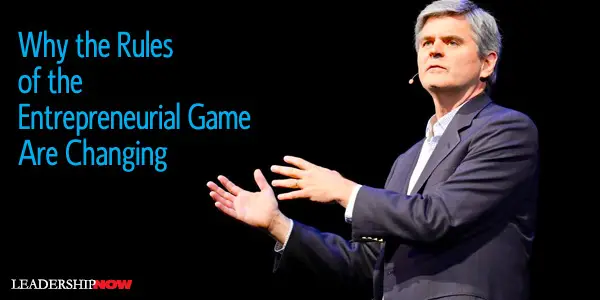
THERE WAS A TIME when AOL was how most Americans got online. Co-founded by Steve Case, American Online at its peak handled nearly half of U.S. Internet traffic and was the first Internet IPO. From his unique vantage point, Case shares his playbook for the future in The Third Wave. Case believes we are now entering the Third Wave of the Internet. The First Wave was building the Internet. The Second Wave was building on top of the Internet. And the Third Wave is integrating the Internet in seamless and pervasive ways throughout our lives.
Leading on the Third Wave of the Internet The Third Wave is about leveraging partnerships. Entrepreneurs of the Third Wave will spend a great deal of time focused on things other than tech as they work to connecting the Internet to everything else. It will be a matter of connecting ideas to create context. “The entrepreneurs of this era are going to challenge the biggest industries in the world, and those that most affect our daily lives. They will reimagine our healthcare system and retool our education system. They will create products and services that make our food safer and our commute to work easier. The Third Wave of the Internet will be defined not by the Internet of Things; it will be defined by the Internet of Everything. We are entering a new phase of technological evolution, a phase where the Internet will be fully integrated into every part of our lives… As the third wave gains momentum, every industry leader in every economic sector is at risk of being disrupted.” For example, education will be more personal, more individualized, and more data driven. “Education innovators were often too focused on technology in the First Wave, and too much on content in the Second Wave. The winners in the Third Wave will leverage technology and focus on great content, but also understand the importance of context and community.” Case believes that if you are to start a successful company in the Third Wave it’s going to come down to partnership, policy, and perseverance. Can You Work with Others? Your partnership skills may very well be the determining factor in the success or failure of your product. Partnerships help to bring credibility, momentum and a sense of inevitability. Can You Work with the Lawmakers? The government is a key force in the Third Wave. Third Wave entrepreneurs will need to figure out how to work with governments. “No matter how good an idea, a Third Wave company that lacks a clear strategy for policy is a dangerous gamble for investors. It is not that success is impossible, but the odds make it a difficult bet.” Are You Adaptable? Of course perseverance is critical in nearly everything of any importance. But Third Wave entrepreneurs will need to have a special kind of perseverance in a changing world to manage tensions. “The winners of the Third Wave will be those who chase big-impact ideas with a sense of urgency—but also methodically and diplomatically. It requires a fresh perspective and the ability to look a new paradigms without being burdened by legacy dogma.” He adds, “Third Wave entrepreneurs must find a way, then, to bring both viewpoints to bear—the nuanced perspective of the defending incumbent and the relentlessly disruptive mind-set of an entrepreneur on the attack.”
Case makes a distinction between “startups” and “small business” especially where policy is concerned. While startups are businesses that can scale quickly and disrupt an existing category, small businesses are focused on steady growth in the long term. More to the point: “The difference between the two is reflected both in the kinds of problems they are trying to solve and in their effect on the broader economy. Indeed, it is not small businesses but new business startups that account for nearly all of the net new job creation in the United States.” Collaboration is Key On a final note, Case reiterates: “Entrepreneurs as ‘Soloists’ will be replaced by orchestras playing a stronger, more credible tune. If you want to go far in the Third Wave, you must go together.” 
Posted by Michael McKinney at 06:49 PM
01.26.12

Leading Views: Resilience
Norm Brodsky and Bo Burlingham, authors of Street Smarts say that the essential quality for business success is resilience—“the ability to bounce back from failure—to turn around a bad situation—to profit from your mistakes.” For the benefit of first-time entrepreneurs the offer four points that lead to business success:

Posted by Michael McKinney at 09:52 PM
01.08.09

One More Time: Resilience is Key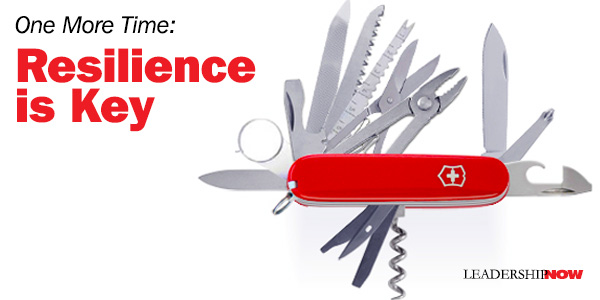
IN The Knack, a book for entrepreneurs, Norm Broadsky and Bo Burlingham respond to the question, “What does it take to be a successful entrepreneur?” The most important quality is resilience. “I’m talking about the ability to bounce back from failure, to turn around a bad situation, to profit from your mistakes. They continue: That’s because everybody makes mistakes, plenty of them. What’s more, we keep making them as long as we’re in business. Sure, we like to think we’ll eventually get so smart we won’t make mistakes anymore. Forget about it. You’ll never stop making mistakes. Hopefully, the new ones won’t be the same as the old ones, but they’ll be equally painful. They’ll bug you just as much. They’ll make you just as mad. As upset as you get, however, it’s important to bear in mind that failure is still the best teacher around. You’ll do fine as long as you’re open to the lessons it’s trying to teach you. And a concluding thought from an article in the New York Times, Innovation Should Mean More Jobs, Not Less. Geoffrey A. Moore, author of Dealing with Darwin, comments: “America is probably the best culture in the world at failing,” he said. “We’re willing to navigate in a fog and keep moving forward. Our competitive advantage tends to be at the fuzzy front end of things when you’re still finding your way. Once the way has been found, we’re back at a disadvantage.” 
Posted by Michael McKinney at 12:29 AM
|
BUILD YOUR KNOWLEDGE
 

How to Do Your Start-Up Right STRAIGHT TALK FOR START-UPS 
Grow Your Leadership Skills NEW AND UPCOMING LEADERSHIP BOOKS 
Leadership Minute BITE-SIZE CONCEPTS YOU CAN CHEW ON 
Classic Leadership Books BOOKS TO READ BEFORE YOU LEAD |
|